|
Car Musings (2019)
Book Review: 'Mickey Thompson: The Untold Story of the Original Speed King' by Tom Madigan
When I was in high school and was dreaming of becoming an engineer, Mickey Thompson was my hero. In 1960, he developed and built the unconventional Challenger I streamliner, powered by four Pontiac V8 engines, and used it to set a one-way top speed of 406.6 mph at the Bonneville Salt Flats. Thompson was the first American to break the 400-mph barrier and Challenger I remained the fastest piston-powered car. Photos of Mickey and his Challenger were on the cover of just about every car buff magazine of the period.
This book is a biography of the man, based on interviews done by the author (the late motorsports writer and former drag racer, Tom Madigan) in the early 1970s. The book covers Mickey's hardscrabble childhood, his early entrepreneurial endeavors, his ability to do more with less and his evolution from just another racer to ... (more >>>)
Book Review: Those Were The Days … Buick Riviera 1963-73' by Norm Mort
"Those Were The Days …" is a series of small (7.5 x 8 inches), 100 or so page, softcover books from Veloce Publishing about specialty automotive subjects. The books are moderately-priced ($25) and chock-full of photos, mostly in full color. Norm Mort's Buick Riviera book is knowledgeably-written and has many photos, some factory images, as well as color ones from members of the Riviera Owners Association.
Surprised by the success of the four-seater Thunderbird, General Motors decided that it needed a personal luxury car offering. A clay model was rendered and presented to Cadillac, to be called ... (more >>>)
"Never Give Up, Never Surrender!" That's what they said on 'Galaxy Quest'. Michael Lamm is a respected auto writer. I've read much of his stuff and purchased his wonderful book, 'A Century of Automotive Style', over 20 years ago. I recommend it highly. It's probably the best tome on car design and covers everything from the coachbuilders of the 1920s and '30s to the in-house design stories at automobile manufacturers.
Michael Lamm is now 83 years old and is still fixing his old cars. But he has to be more careful these days because he's taking a blood thinner. "Yet as you might suspect, tinkering is not the same at 83 as it was at 18. Certain realities have crept in, some of which remind me of my mortality. And with the realization that I'm definitely 83, mortality does come up as a topic of discussion."
"I notice, too, that I'm not as physically strong as I used to be. At 18 - when I really was 18 - I could toss 100-pound bags of horse oats onto car fenders, no problem. Today, a 35-pound carton of books makes me grunt. I feel my lack of strength especially in my arms, hands and fingers, as when I'm pinching pliers or replacing a wheel.
My knees also remind me of my age. If I'm squatting or sitting on the floor, I now have to grab hold of something to help me stand up. Nor are my eyes what they used to be. I'm much more dependent on drop cords and those wonderful little LED flashlights - the type that can shine down into hidden crevices. And those 12-hour days don't happen anymore."
Lamm currently drives a 1964 Jaguar E-Type roadster and a 2000 Porsche Boxster S. Good for him.
By Grabthar's Hammer, Mike, keep enjoying your old cars. Godspeed. (posted 12/2/19, permalink)
Book Review: 'The Last Shelby Cobra: My Times With Carroll Shelby' by Chris Theodore
I don't think anyone can write a true autobiography of Carroll Shelby. He was a multi-faceted, talented individual who was often mercurial, petty and changed the world of racing, performance cars and created an image which evolved into a legend.
The late auto editor David E. Davis sang Shelby's praises even though Shelby apparently cheated Davis out of money. When Shelby's last from-the-ground-up automotive venture, which produced the Oldsmobile-powered Shelby Series I sports car in 2000 or so, went belly-up it caused a lot of people to lose their deposit money, etc. Ol' Shel (his-own-self) apparently got away scot-free because he had good lawyers.
No one can deny the impact of ... (more >>>)
Book Review: 'GQ Drives: A Stylish Guide To The Greatest Cars Ever Made' by Paul Henderson
GQ dates back to 1931, when it was strictly a men's fashion magazine. In 1958, it was acquired by Esquire and renamed Gentlemen's Quarterly. Over the years, the magazine evolved beyond fashion, also covering food, drink, style, travel and, of course, cars. In 1967, it received a new moniker: GQ.
This 256-page book was compiled by GQ Associate Editor, Paul Henderson. He also wrote some of the articles. Many, if not most of these articles appeared in past issues of GQ.
It has been said that ... (more >>>)
Bad Cars Cause Global Warming: I offer the following as evidence:
• In 1934, Chrysler offered the iconically ugly, unsuccessful Airflow. In 1934, the New York Times reported, "New Evidence Supports Geology's View That the Arctic Is Growing Warmer."
• Studebaker sullied the reputation of its 'European-look' line by introducing the tall, ungainly and poorly-built '54 Studebaker Conestoga station wagon. A 1954 NYT article carried this ungainly sentence: "The particular point of inquiry concerns whether the ice is melting at such a rate as to imperil low-lying coastal areas through raising the level of the sea in the near future."
• The Edsel was introduced as a 1958 model. New York Times headline from the same year: "At present, the Arctic ice pack is melting away fast. Some estimates say that it is 40 per cent thinner and 12 per cent smaller than it was fifteen years [ago]."
• The Ford Pinto made its debut in the 1971 model year. In 1971, the Times noted, "Study Says Man Alters Climate; U.N. Report Links Melting of Polar Ice to His Activities."
• The 1982 model year saw the appearance of the awkwardly-styled Ford EXP two-seater coupe. The New York Times wrote awkwardly, "Because of global heating attributed to an increase in atmospheric carbon dioxide from fuel burning, about 20,000 cubic miles of polar ice has melted in the past 40 years, apparently contributing to a rise in sea levels."
• In 2004, the Times opined, "There is an awful lot of Arctic and glacial ice melting." General Motors opined, "America will love our new small car - the (awful) Chevrolet Aveo."
I rest my case. (posted 11/18/19, permalink)
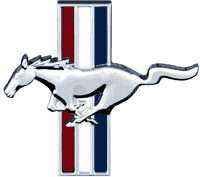 Damaged Pony: Within the next week or so, Ford will unveil a "Mustang-inspired" electric four-door crossover. The name is rumored to be 'Mach-E'. I hope it has neither the Mustang name or pony badging on it. Arbitrarily slapping iconic brand names on other products is called line extension. Line extension may initially provided added sales interest but it can be a double-edged sword. (Update: Unfortunately, it does have pony badging and is known as the Mustang Mach-E.) Damaged Pony: Within the next week or so, Ford will unveil a "Mustang-inspired" electric four-door crossover. The name is rumored to be 'Mach-E'. I hope it has neither the Mustang name or pony badging on it. Arbitrarily slapping iconic brand names on other products is called line extension. Line extension may initially provided added sales interest but it can be a double-edged sword. (Update: Unfortunately, it does have pony badging and is known as the Mustang Mach-E.)
Back in 1980, Al Ries and Jack Trout wrote of the dangers of line extension in their excellent book, 'Positioning: The Battle For Your Mind’. Over the long term, line extension waters down the brand. It damages the primary, frequently without any profit benefit from the extension.
Did Cadillac make any money from that bicycle they introduced 15 years ago? I doubt it. Is Land Rover making any money from its brand of coffee? Will all the variations on the Mini eventually kill the brand? When first introduced, Mini was a gotta-have little one body-style, two-door car with long waiting lists and price-gouging. Today, with a plethora of confusing offerings, Mini now struggles to sell 3,000 vehicles per month. Porsche sells waaay more vehicles than Mini at thrice the price.
Over the years, most 'regular' beer brands saw sales of their primary product hurt by light beer and other line-extending variants. Today, most old-name beers have seen their sales supplanted by craft beers, in part due to customer confusion from all those line extensions. The number of U.S. breweries reached an all-time record high of 5,005 in 2016; 99% are small, independent craft beer makers with laser-focused market offerings.
When the two-seater 1955 Ford Thunderbird made its debut, ads for regular Fords touted their "Thunderbird look." These ads continued through the 1957 model year. When the four-seat personal luxury Thunderbird appeared for the 1958 model year, Ford quashed the idea that other Ford models might be Thunderbird-inspired and promoted the Squarebird almost as if it was a stand alone brand. Because the "Thunderbird look" campaign was short-lived, it didn't detract from Thunderbird's image. This could be acclaimed as a 'good' way to borrow a desirable brand's identity but, comparisons to today's market may not be applicable because it has been 65 years since the little T-Bird first appeared and because the Ford brand itself lacks identity due to an ever-changing product line-up. But, like Thunderbird used to be, Mustang is a strong brand and Ford should be very cautious about stirring the pot … or perhaps more aptly, diluting the soup.
Corey Lewis of TTAC speculated, "This EV will most likely spell the end of the traditional Mustang format. By traditional I mean two-doors, coupe or fastback shape, rear-drive, and an engine which has some gasoline in it. "No way!" You'll think, "Mustang owners will never give up their V8!" But there won't be a choice here. 2021 arrives, there's a new Mustang. The V8 passes during the first refresh around 2024, leaving turbo fours. Next step, perhaps a year or two later: greater hybridization. But thet'll be alright, because the ultimate consolation prize arrives with a final refresh (or even earlier): all-wheel drive. By the time all of these pieces fall into place, the 2021-22 Mustang will be long in the tooth = time for a Commemorative Final Run Edition."
He concluded, "And just as Americans have given up their convertibles, luxury coupes, station wagons, and minivans before, so too will they give up their pony cars. Sales of the traditional Mustang are falling year over year, its customer base shrinking. The Mustang EV4 is the future, and that's a fact."
Mustang is the only iconic brand Ford has. I hope they don't kill it off or line extend it to death. America needs a great pony car. And Ford needs a halo car that people can afford. (posted 11/12/19, permalink)
I Saw This At Pebble Beach In 1996: The 1996 Zagato Raptor is a concept car, resulting from Lamborghini partnering with Italian coachbuilder Zagato. The Zagato Raptor was "developed as a stop-gap model between the Diablo and its proposed successor, the Canto, another stillborn design that gave way to the Murcielago. The car is distinctly more rounded than the wedge-like Diablo, but it's no less wild with its wide haunches, sci-fi taillight bar, and aggressive roof scoop. The party piece, though is the huge tilting canopy for access, which also featured a removable targa roof."
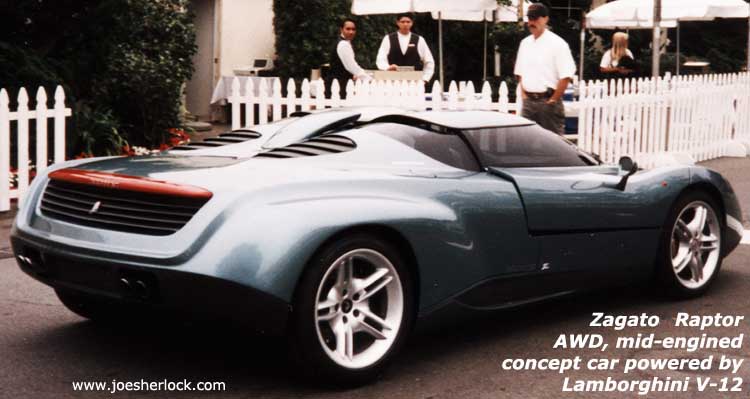
It looks even better in person and sounds … ummmm … raptor-like. It was very low.
"The entire body was made of carbon fiber, too, and that made it about 660 pounds lighter than a Diablo. Some of the weight savings also came from the fact that it lacked the traction control and ABS that came with a Diablo. The Raptor naturally was quick as it shared the Diablo's 6.7-liter V12 and the Diablo VT's 6-speed manual gearbox and all-wheel drive. It could hit 60 mph in under 4 seconds." It will be auctioned at the end of the month in Abu Dahbi. (posted 11/7/19, permalink)
Good Wood: Recently, a rare, gorgeous burgundy 1941 Chrysler Town & Country 9-passenger "barrel back" woodie station wagon fetched $277,760 at the Bonhams auction held at the Simeone Foundation Automotive Museum in Philadelphia.
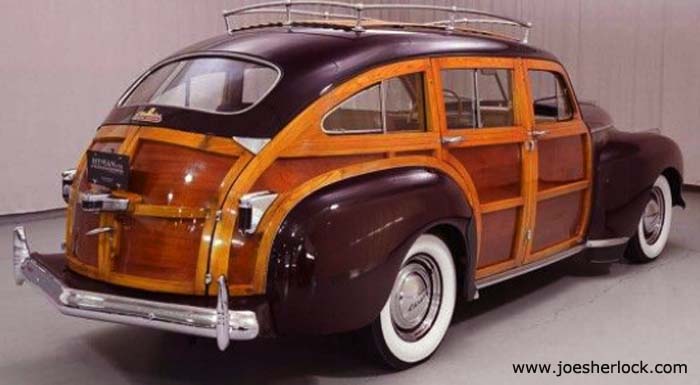
You can't appreciate the style of these old barrel backs until you see one in person. These station wagons, produced, during the 1941-42 model years, were the first wagons with an all-steel roof. It used the roof of the concurrent Chrysler Imperial 4-door 8-passenger limousine, which led to a rear loading configuration with rounded wooden double doors - 'Barrel Back' doors - that opened out from the center beneath the fixed rear window.
Fewer than 1,000 barrel backs were produced. While the Town and Country woodies were continued after World War II, the barrel back was dropped from the line. (posted 11/5/19, permalink)
Book Review: 'Jaguar: The Art Of The Automobile' by Zef Enault and Michael Levivier
This large (10 x 12 inch), 240 page book contains the complete history of Jaguar and is packed with high quality photographs, many in color and many from Jaguar's historical archives.
This is much more than a picture book, it tells a great story - warts and all, surprising since the Jaguar Historic Trust was involved in creating the book. It is no mere puff piece. The story begins in ... (more >>>)
 Remembering Honest Charley: Those of us of a certain age remember the small, crowded b/w ads in various 1950s-1960s car buff magazines for Honest Charley's Speed Shop. Remembering Honest Charley: Those of us of a certain age remember the small, crowded b/w ads in various 1950s-1960s car buff magazines for Honest Charley's Speed Shop.
For over 70 years, Honest Charley and the distinctive trademark have been synonymous with styling accessories and speed equipment for automobiles. The firm was started in 1948 by Honest Charley Cardin of Chattanooga, Tennessee.
Honest Charley's speed shop expanded its business by introducing unique and entertaining catalogs. The early issues were actually hand-drawn by Honest and his daughters. He created a caricature of "Hisself" for a logo and always drew little cartoons in the margins.
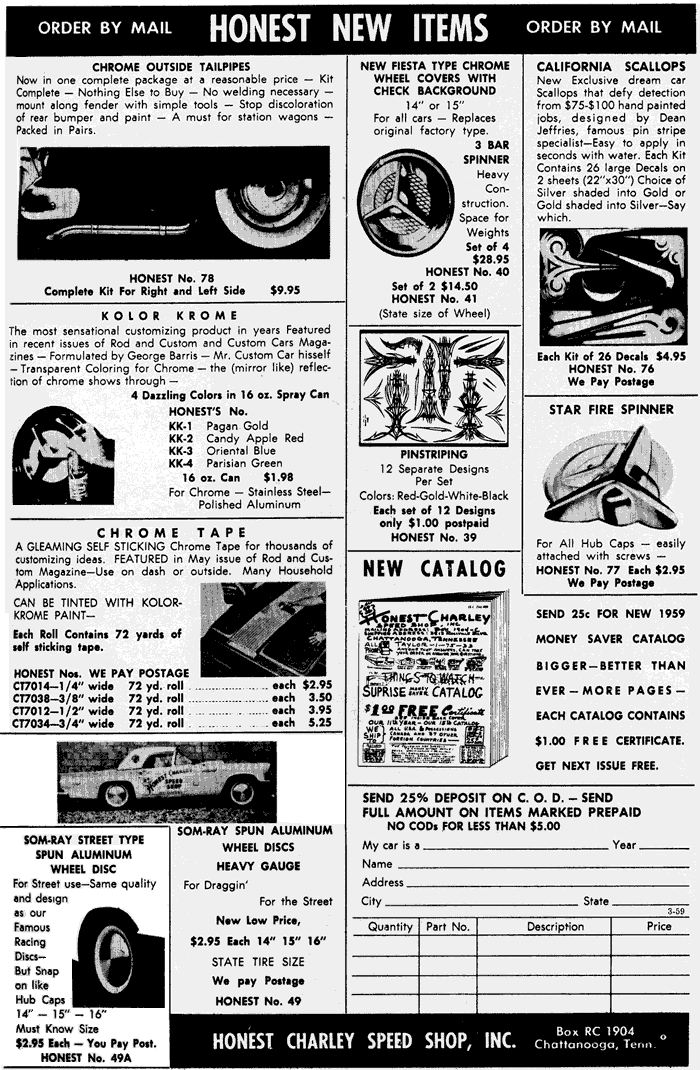
Honest Charley died in 1974. His son-in-law and partner Robert J. Espy continued to operate the company until it succumbed in 1990 to ever-increasing competition of larger retailers entering the market and restrictive environmental regulations regarding aftermarket alteration of automobiles. In 1998, Coker Tire of Chattanooga acquired the brand rights and revitalized the name Honest Charley's Speed Shop as an internet retailer. (posted 10/28/19, permalink)
Coal Power: Revently, MotorWeek did a segment on Salt Lake City's push for electric vehicles, including public transit buses and taxpayer-funded charging stations. There was much sanctimonious talk of how SLC is helping save the planet from pollution. The people interviewed were smug and preachy.
The reality is a bit different. In 2017, 70% of Utah's net electricity generation came from coal. So, those lumbering, inefficient electric buses roaming SLC's streets are as dirty an old time coal-fired steam locomotive.
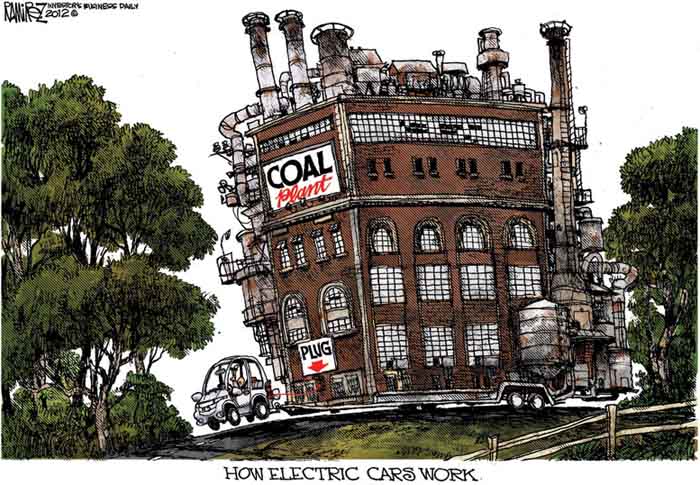
Also, among the 50 states, Utah has the fourth highest number of producing oil and natural gas leases on federal lands. Utah has 3 of the 100 largest U.S. natural gas fields, ranked by proved reserves, and nearly 1% of the nation's proved natural gas reserves.
Anyone who belies that Salt Lake City's electric vehicles are lessening pollution is tethered to reality by a badly-frayed strand of dental floss. (posted 9/26/19, permalink)
Book Review: 'Auto Racing In The Shadow Of The Great War: Streamlined Specials and a New Generation of Drivers on American Speedways, 1915-1922' by Robert Dick
In the first decade of the 20th Century, American race cars were crude and basic, as were regular automobiles of the period. European cars, especially those from Germany and France, offered technical innovations and more sophisticated powertrains and suspensions. Few European race cars made it to the U.S. prior to World War I. In Europe, the French Grand Prix, held one week after the assassination of Archduke Ferdinand of Austria, was the last ... (more >>>)
Re-creating A Long-Lost Prototype: Bentley's Mulliner coachwork division has built a one-off re-creation of the 1939 Bentley Corniche prototype, a streamlined sedan which never went into production. It is slated to debut at Salon Privé (held at Blenheim Palace in the UK) this week.
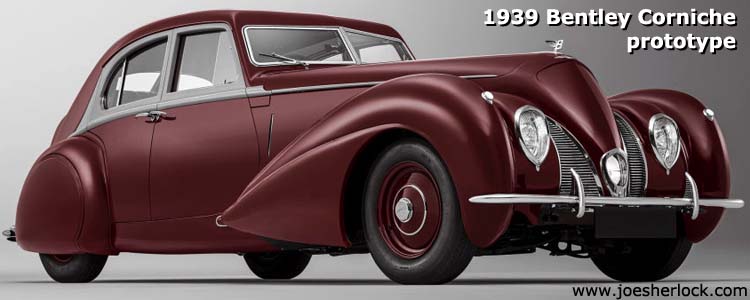
"Initially conceived as a high-performance version of the technologically-advanced Mark V saloon scheduled to debut in 1939, the Corniche was inspired by a sporting Bentley privately commissioned by Greek racer André Embiricos. Created by Bentley in association with a team of outsiders including French designer Georges Paulin, the Corniche ditched the traditional Bentley stand-up grille in the name of streamlining. Featuring bodywork by Paris coachbuilder Vanvooren, the 1939 Corniche portended the future of auto design as a whole in addition to informing postwar Bentleys such the R Type Continental. Performance-focused details included thinner steel for light weight and a tuned version of the Mark V engine mated to an overdrive transmission, both of which helped the Corniche top 100 mph during testing at the Brooklands circuit."
More photos can be seen here.
To people my age, the brand Bentley conjures up badge-engineered Rolls Royces with different grilles, which was the case from 1962 to the early 1980s. It's no longer true since both brands now have different owners - Volkswagen for Bentley and BMW for Rolls. Both British stalwarts are now owned ... by the Germans. Rolls Royce took over Bentley in 1931 but, even by the late 1930s, there was still an effort to differentiate Bentley from RR. Hence the '39 Bentley Corniche prototype, which looked a bit Lincolnesque in front, perhaps as a tribute to Edsel Ford. The waterfall grille and headlights are reminiscent of late 1930s Lincolns. The Corniche never went into production because World War II intervened.
The car was undergoing road-testing in Europe when war broke out. The Corniche saloon was parked in Dieppe (a port in Upper Normandy France on the English Channel) awaiting shipment back to England when this sole prototype was destroyed in air raid ... by the Germans. Now it has been resurrected for car enthusiasts and historians to enjoy. (posted 9/4/19, permalink)
Book Review: 'Driven: An Elegy To Cars, Roads & Motorsport' by John Aston
Mr. Aston's motoring autobiography is about one man's love of cars, especially Caterham Sevens, which he used to race. While Aston is British and some of cars, racing circuits and slang may be unfamiliar to American readers, his car obsession is familiar to all car guys, regardless of nationality.
As a young man, he poured over ... (more >>>)
Book Review: : 'F1 Mavericks: The Men and Machines that Revolutionized Formula 1 Racing' by Peter Biro and George Levy
Let me begin by stating that the photography in this coffee table-sized book is nothing short of spectacular. Much of it is from noted photographer, the late Peter Biro. The book mentioned Bernard Cahier and that brought back memories of reading the French photo-journalist's reports in Road & Track. Bernard's prose brought the races to life and his driver profiles and general racing gossip added a conversational note to his writings.
As most readers know ... (more >>>)
2019 Monterey Week: Last week's annual car festival offered the usual mix of spectacular and fascinating vehicles on display as well as always-interesting auto auction results. Once simply the Pebble Beach Concours, this car-centric, scenic venue has been expanded to include week-long events, including exclusive new vehicle launches by manufacturers as well as numerous track and rally events. And humongous traffic jams as people try to attend every attraction.
This year, $245.5 million worth of wheels were sold at six auction houses, according to Hagerty, the classic-car insurance and market-research company. Thiss figure represents a decline of 34% from last year, even though Bonhams and RM Sotheby's added an early and extra day to their annual collector car auctions during Monterey Car Week. The classic-car market has lost some traction from the 2014-2015 peak, when Monterey sales totaled $396 million.
Hagerty added that average sales price, media sales price and sell-through rates were all down in 2019 compared with year-ago numbers. The sell-through rate on cars valued at $1 million or more was only 42% this year in Monterey, compared with a 55% figure for the auctions taking place during the previous seven months.
A 1994 McLaren F1 coupe in LM specification brought $19.805 million at RM Sotheby's, which also sold a 1965 Ford GT40 prototype roadster for $7.65 million. The auction house also sold a 1962 Ferrari 250 GT SWB Coupe for $8.145 million. Meanwhile, at Gooding and Company, a 1958 Ferrari 250 LWB California Spider fetched $9.905 million and the Ferrari 312T that Niki Lauda drove to victory in the 1975 French Grand Prix went for $6 million. A 1898 Riker Electric Stanhope Runabout sold for $605,000.
Bidding at RM Sotheby's for the iconic aquamarine 1939 Porsche Type 64, often called the Nazi Porsche, came in at $17M and stalled without crossing the reserve - no sale. Gooding failed to sell the gorgeous 1953 Alfa Romeo 6C 3000 CM Superflow IV, a glass-roofed Pinin Farina-bodied show car, which - in an earlier iteration, had swoopy, clear Plexiglas front fenders. The car is powered by a 275 hp, 3.5-liter twin-cam straight six, with six individual Weber carburetors and dry sump lubrication. Power is transmitted to the rear wheels by a five-speed gearbox and aluminum-cased rear differential. It is now being offered with an asking price of $5.5 million.
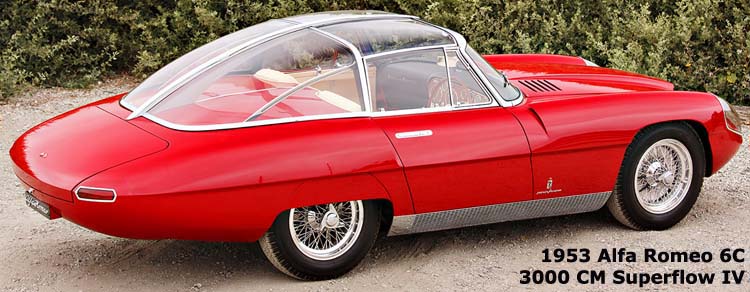
RM Sotheby's sold the iconic silver 1965 James Bond Aston-Martin DB5 for $6.4 million. This original James Bond-spec Aston-Martin DB5, used as a promotional vehicle for the 1965 Bond film 'Thunderball', is equipped with gadgets including a bulletproof rear glass shield, smoke screen, etc.
"The Bond car was one of two 1965 DB5s commissioned by Eon Productions, the British film company, and used as promotions for 'Thunderball'. Neither were used on screen, but they received all the gadgets from the film, installed by Aston Martin and built to actually be used and be reliable. In addition to the gadgets mentioned above, there are bumper overriders, front guns and an oil slick dispenser, plus toggle switches, weapon drawer and tracking screen."
The following lesser cars - from the televised Mecum Auction - caught my eye:
• A black 1934 Ford five window coupe (with red wire wheels and rumble seat) found a new home for $69,000.
• A yellow supercharged 1937 Cord 812 Spartsman convertible coupe fetched $235,000.
• A maroon 1940 Ford DeLuxe convertible sold for $41,000.
• A brown 1940 Ford DeLuxe woody (with 12 volt conversion plus alternator) fetched $72,000. I don't usually like brown cars but, on this woody, the color looked perfectly suitable.
• A handsome maroon 1941 Cadillac Series 60 Fleetwood four-door sedan gaveled down at $30,000.
• A black 1948 Lincoln Continental convertible (with red leather interior and V12 engine), sold for a mere $18,000. Later, an almost identical example gaveled down at $20,000. Then, a rare 1942 example fetched a more reasonable $50,000. Twenty years ago, such LC convertibles sold for $45-70,000.
• A cream 1948 MG-TC with black fenders sold for $17,000. These old TCs were cool-looking with their big tires and short body but were quite slow, even by early postwar standards.
• A gorgeous maroon 1951 Jaguar Mark V drop head coupe (with tan leather interior, four-speed transmission, 3.5-liter straight six engine and rare LHD steering configuration) sold for $70,500.
• A 1955 copper Corvette Roadster with the then-new 265 cu.in. V8 engine found a buyer at $95,000.
• A white 1956 Mercedes-Benz 190SL convertible (with removable hardtop) sold for $94,000.
• A black 1956 Jaguar XK140 roadster (with burgundy leather interior) fetched $87,500.
• A light blue 1959 Lincoln Continental Mark IV four-door hardtop sold for only $10,000. My friend Maury Willard once owned a turquoise example of this big barge.
• A 1962 black Jaguar E-Type convertible (with red leather interior) found a buyer at $125,000.
• A red 1963 Buick Riviera - the first year of Riv production - sold for $20,000. My friend Marty Hayes' dad had a white one, until he traded it for a dark green 1965 Riv.
• A pale-yellow 1967 Volkswagen Beetle convertible sold for $20,000. 1967 Beetles have a special place in my heart.
• A yellow 1969 Lotus Europa S2 Federal mid-engined coupe fetched $28,000.
• A gold 1972 Maserati-powered Citroën SM coupe found a new home for $41,000. Later, a '73 blue example sold for $46,000.
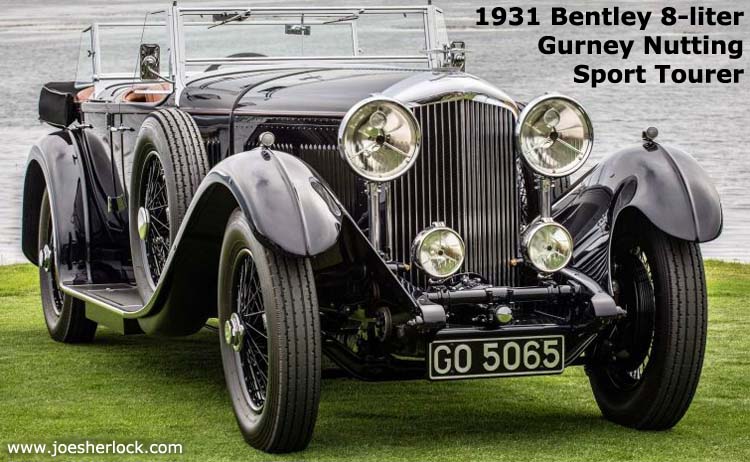
At Sunday's Pebble Beach Concours, the pinnacle and conclusion of the Monterey Week experience, the much-coveted Best of Show was awarded to a 1931 Bentley 8-liter Gurney Nutting Sport Tourer owned by Sir Michael Kadoorie, the Hong Kong-based billionaire hotelier and investor. Given Hong Kong's precarious status, Sir Michael may want to keep this valuable asset stateside for a while. (posted 8/20/19, permalink)
Book Review: 'The Electric Car in America, 1890–1922: A Social History' by Kerry Seagrave
In 1895, it would have been difficult to place bets on the choice of motive power for the new-fangled automobile. Steam was familiar from locomotives and could run on almost any kind of fuel. But it took a long time to get the boiler up to operating temperature and frequent water stops were necessary. Gasoline motors were temperamental, the crank could break one's arm if it snapped back, engines were noisy and emptied noxious smoke.
Electric power looked like a winner back in those days .... (more >>>)
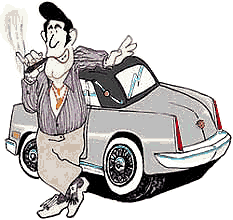 Investing In Wheels: Cars from the 1970s, '80s, and '90s are white-hot in their popularity. But older cars, not so much. That means iconic vehicles such as Mercedes SLs and Chevrolet Corvettes aren't expected to gain real value anytime soon - and according to the latest Hagerty Vehicle Rating, even the stunning Porsche 911 Turbo and the hipster-cool Porsche 924 have already had their day in the sun. Same with pagoda-roofed 1963-71 Mercedes-Benz 230SL/280SL and 1967-71 Mercedes-Benz 280SE. One exception is 1960s-era except for VW Microbuses. But this too shall pass. Investing In Wheels: Cars from the 1970s, '80s, and '90s are white-hot in their popularity. But older cars, not so much. That means iconic vehicles such as Mercedes SLs and Chevrolet Corvettes aren't expected to gain real value anytime soon - and according to the latest Hagerty Vehicle Rating, even the stunning Porsche 911 Turbo and the hipster-cool Porsche 924 have already had their day in the sun. Same with pagoda-roofed 1963-71 Mercedes-Benz 230SL/280SL and 1967-71 Mercedes-Benz 280SE. One exception is 1960s-era except for VW Microbuses. But this too shall pass.
"The adage, 'You can't sell an old man's car to a young man' is true for a reason. Buyers tend to get vintage cars they lusted after as kids - so Volkswagen Golfs and Buick GSXs are popular again, 30 or 40 years on. Conversely, the 1968 Lincoln Continental your dad kept parked in the garage for years may not be as appealing." Same with cars from the 1930s, such as my 1939 Plymouth.
I saw this happen with two-seat Thunderbirds in the 1990s. Good (but not concours examples) had zoomed in price during the 1980s but stalled in the early '90s at around $25,000. Adjusted for inflation, they're actually worth a little less in 2019. Same for the 1946-48 Chrysler Town & Country convertibles, the 1940-48 Lincoln Continentals and Packard 120s from the 1930s.
At the 2018 Scottsdale auctions, a rare 1942 Lincoln Continental coupe - one of 200 made during the war-shortened '42 model year - was finished in dark green and sold for $45,000. A black 1948 Lincoln Continental cabriolet (with red leather interior) fetched $54,000. These older Connies haven't budged much in price over the past 25 years. A 1931 Ford Model A station wagon once owned by Mary Tyler Moore went for a mere $24,200. Model A prices haven't budged since the 1960s.
People start buying old cars when they reach their mid-40s. That's when most guys start getting what economists call 'disposable income' and what we call 'pissing-around money'. A 45 year-old was born in 1974 and was six by 1980 - a time when cool new cars were almost nonexistent.
Today's 45 year-old graduated from high school in 1992, when cars were mostly crap. I've never heard anyone say, "I'm saving my money so I can someday buy a fully-restored '92 Buick Riviera. Or '92 Dodge Daytona. Or Geo Metro." Most don't have a high-school 'car dream' to chase - unlike people of my generation. Today's forty-something is more likely to be spending any excess money on toys of the 1970s and '80s - old Fisher Price stuff, Merlin, Mr. Machine, a J. Chein litho roller coaster, Slip 'n' Slide, G.I. Joe stuff, Stretch Armstrong, Simon, Big Wheel, Green Machine, etc.
My advice: If you have an old car, drive it and enjoy it and stop worrying about its investment value. If you're looking for an investment, buy a good mutual fund. (posted 8/6/19, permalink)
Book Review: 'Lotus Europa - Colin Chapman's Mid-engined Masterpiece' by Matthew Vale
Lotus Cars is a specialty British automaker that manufactures sports cars and racing cars. Lotus Engineering Ltd. was founded by engineers Colin Chapman and Colin Dare in 1952. Many Lotus models have become icons, including the very-basic Lotus Seven, the swoopy aero Lotus Eleven and the Espirit, made famous in a couple of James Bond films.
Vale's book thoroughly covers the Lotus Europa, the company's first mid-engined offering. When introduced in 1967, the Europa was the only ... (more >>>)
Micro-Failure: Hemmings has posted photos from the 1958 Imported Car Show in Los Angeles.
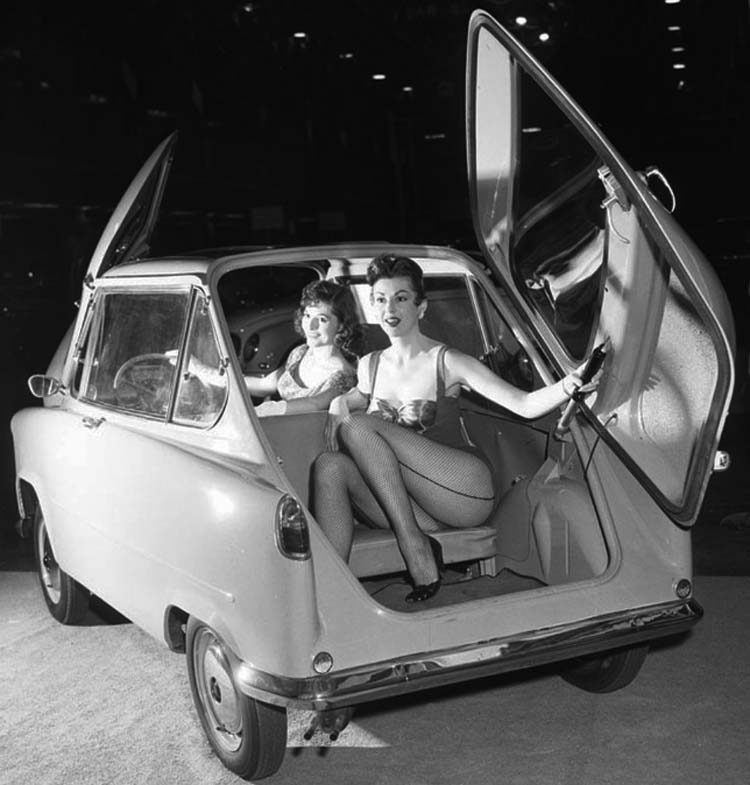
The pix are in black and white but the cars were memorably cool and I especially enjoyed seeing pinup Melody Ward's long, lovely legs in the Zündapp Janus. More revealing NSFW photos of Melody can be found here. And here. Fellow model Sherli Hill occupied the front seat.
The Janus never caught on in America or anywhere else. Only 114 inches long, riding on a 72 inch wheelbase, the little 937-pound car was powered by a mid-mounted 2-stroke one-cylinder, 14 horsepower engine running through a four-speed tranny. The Zündapp microcar had a top speed of only 50 mph - if you were brave.
Production began in June 1957 at the Nürnberg, Germany plant, but after selling less than 7,000 little vehicles in a year, Zündapp abandoned the Janus project, sold the factory to Bosch and concentrated its efforts on its more successful Zündapp motorcycle line.
At 2012's Monterey weekend, Gooding auctioned a pale-blue Janus for $22,000. (posted 7/26/19, permalink)
Book Review: 'Never Stop Driving: A Better Life Behind the Wheel' by Larry Webster, Zach Bowman, Jack Baruth and Brett Berk
'Never Stop Driving' celebrates many segments of the car hobby told in personal terms: falling in love with a car (or cars), the search for the right vehicle, the joy or frustration of car repair, the personalities of fellow car enthusiasts, the fun of driving, the pleasure of discovering a fun escape road, the skill and excitement of racing, the restoration experience and much more. Each author is an expert in one or more facets of automobiles and each contributes a unique and compelling viewpoint.
This hardcover, 192-page book is full of gorgeous color photographs as well. Many are ... (more >>>)
Finned Beauties: Finned mermaid spokesmodel (and comely Las Vegas showgirl) Alyce Keller poses by a finned 1959 Dodge Custom Royal Lancer hardtop coupe at the 1959 Chicago Auto Show. Note the sign in the background: "Fish found fins first … But Dodge made them famous!"
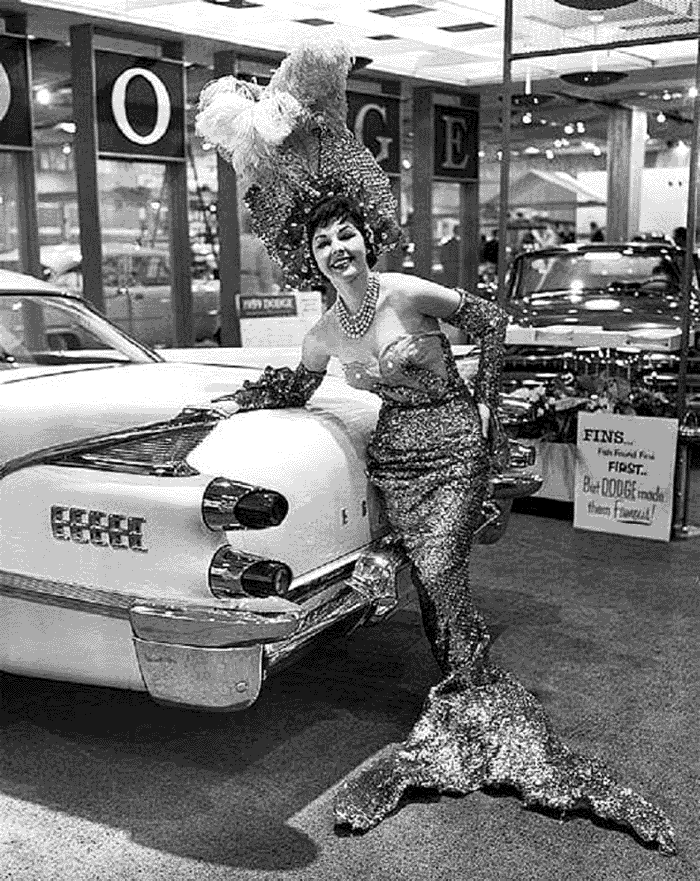
In 1959, Dodge held 8th place in U.S. sales, behind Chevrolet, Ford, Plymouth, Pontiac, Oldsmobile, Rambler and Buick. During the 1959 model year, 284,248 Dodges found buyers. 6,278 Custom Royal Lancer hardtop coupes were produced, with prices starting at $3,201. (posted 7/12/19, permalink)
Book Review: 'The Automobile And American Life, 2d ed.' by John Heitmann
This 7x10 paperback (238 pages, plus notes, bibliography and index) relates the story of how automobiles fundamentally transformed the way people lived shopped, worshipped, socialized and he country's infrastructure, The book contains 47 b&w photos.
Heitmann has filled the book with interesting statistics; here are three that caught my eye ... (more >>>)
Oh No! The legendary 1970 Ferrari Modulo concept car caught fire due to a defective muffler. Damage to the wild one-off seems repairable and even when singed, the car still looks futuristic almost 50 years after it was built.
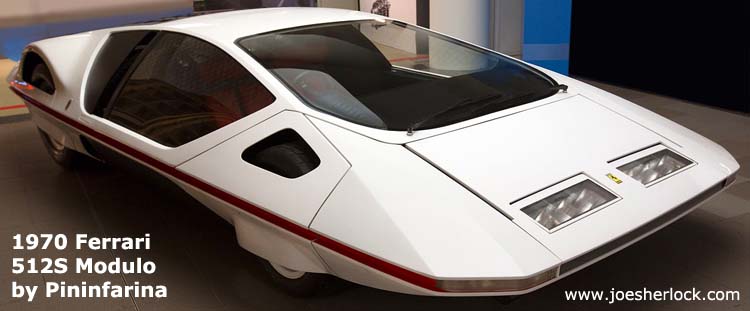
The Ferrari 512S Modulo is a sleek, aerodynamic concept sports car designed by Paolo Martin of the Italian carozzeria Pininfarina, unveiled at the 1970 Geneva Motor Show. Instead of conventional doors, the Modulo has a canopy which slides forward. This wild car is powered by a 5-liter Ferrari V12 engine.
The Modulo was supposed to predict the future of automobiles. Back in 1970, no one thought that, in 2019, many of us would be driving tall, blunt-nosed, truck-like vehicles. (posted 7/3/19, permalink)
Book Review: 'Ask the Man Who Owns One: An Illustrated History of Packard Advertising' by Arthur Einstein
Don't be fooled by the title. This is not just a bunch of reprinted ads with a bit of commentary. Rather, it is a well-presented history of the Packard marque, told in part through its advertising. Arthur W. Einstein, Jr. is an auto enthusiast and advertising executive and does an excellent job making Packard's history interesting.
This 7x10 paperback has 248 pages with additional pages of appendices, notes, bibliography and index. There are 117 b&w photos (mostly reprints of newspaper and magazine advertisements) with a 16 color photos in the center of the book. The book focuses on ... (more >>>)
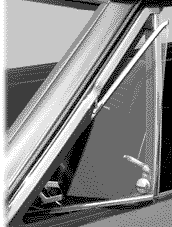 All Hail The Vent Window: The Old Motor has posted an interesting write-up on General Motors' No-Draft Ventilation System, offered to buyers in 1933. A major component was vent windows. All Hail The Vent Window: The Old Motor has posted an interesting write-up on General Motors' No-Draft Ventilation System, offered to buyers in 1933. A major component was vent windows.
"Alfred J. Fischer was listed as the inventor of the new adjustable four-window arrangement on the patent application that was filed on Nov. 28, 1932. It was assigned to the Ternstedt Mfg. Co., a GM subsidiary that manufactured components for the automaker."
My 1939 Plymouth has vent windows. Maybe that's why I always feel better after a drive in the old coupe. The last new car I purchased that had vent windows was my 1967 Volkswagen Beetle.
The 1966 Oldsmobile Toronado was one of the first modern American production cars to use GM's 'Draft-Free' ventilation system, which reduced wind noise considerably by eliminating the conventional vent windows in the front-doors. (Although some earlier cars were absent front quarter windows, including 1955-57 Thunderbird two-seaters, '53-'62 Corvettes, Citroën DS of 1955 onward, Citroën Traction Avant, 1949-'52 VW Beetles.) Removing vent windows also saved money for automakers. By the 1970s, vent windows had been identified as a major source of wind noise (as cars got quieter). As more and more cars came with factory air-conditioning, vent windows were gradually eliminated. After the 1972 model year, the Chevy Nova lost its vent windows. I'm sure that their removal was hastened by the cost savings element.
I think America's decline started when we gave up on Vietnam and took vent windows out of cars. In my mind, these two things happened simultaneously. Both were symbols of our newfound need to value-engineer everything to death and to replace 'Doing The Right Thing' with 'Expedience & Compromise'. I call this phenomenon the Robert McNamara Effect. I would also point out that intelligence test scores stalled in the mid-1970s and have declined in recent numerical reasoning sub-tests. Could it be the lack of fresh air? In the mid-1970s, companies hopped on the Save Energy bandwagon and sealed up windows in offices and factories. Then they set their heaters and A/C systems on maximum recycling mode. Vent windows disappeared from automobiles during this same period, further reducing the amount of fresh air available to humans. Fresh air was further reduced by energy-efficient home construction.
People need fewer design compromises and more fresh air. Unfortunately, they're now too dumb to realize it. (posted 6/19/19, permalink)
Forties Sleek: Daniel Strohl has posted an interesting story on Hemmings about the Fageol Supersonic, which debuted at the Indy 500 in 1949. Somewhat reminiscent of the mid-1950s Mercedes SLR, the amazing thing is that the Supersonic was built on a modified Lincoln chassis and powered by a hopped-up bus engine.

The aerodynamic two-seater had a top speed of 150 mph, pretty amazing for a street car of the late 1940s.
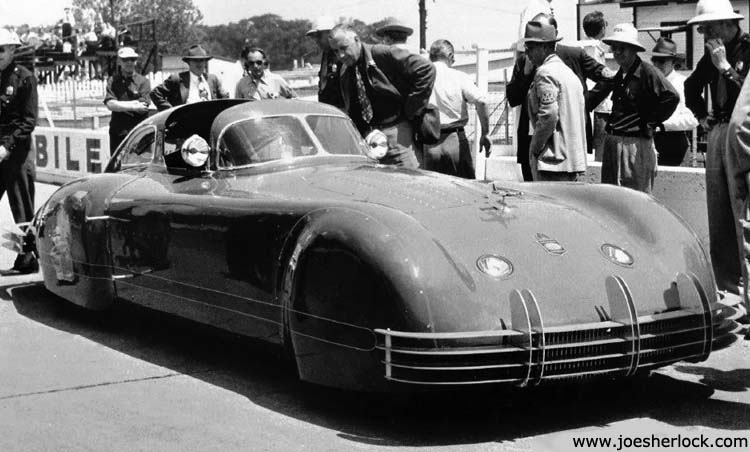
"Fageol had the Twin Coach (bus) mechanics install a 275 hp 404-cu.in. aluminum Fageol racing engine, mated to the Lincoln's overdrive transmission. Because the Fageol engine had much more bottom-end torque than the V-12, Ray Fageol said, his father decided to call up a friend at Packard to order one of that company's rear axles with a 4.06:1 ratio, which he then had mounted to the Lincoln's springs. Lou Fageol then spent some time modifying the suspension, adding torsilastic springs up front and a cross-link system designed to keep the chassis from leaning out in turns." (posted 6/17/19, permalink)
Book Review: 'Mini: 60 Years' by Giles Chapman
Introduced in the Spring of 1959, the original Mini (sold as the Austin Se7en and the Morris Mini-Minor) was an exercise in clever packaging and minimalist design. It had sliding windows, and external door hinges to increase useable storage space and was powered by a small four-cylinder engine mounted transversely to save room and coupled to a front-wheel drive transaxle.
Wheels were tiny (10 inches) to increase interior space. The car seated four passengers in relative comfort but rode on an 84-inch wheelbase and was only 120 inches long - more than three feet shorter than a VW Beetle.
The Mini came about because of ... (more >>>)
When Air Was Free:
Book Review: 'Charles Clifton of Pierce-Arrow: A Sure Hand and a Fine Automobile' by Roger J. Sherman
Now almost forgotten except by diehard antique auto enthusiasts, Pierce-Arrow was once a well-engineered, very desirable luxury auto marque. Pierce-Arrow Motor Car Company was a bicycle company which began offering passenger automobiles, then trucks and, later, buses.
In 1909, President William Howard Taft ordered two Pierce-Arrow automobiles to be used for state occasions. In 1914, Pierce-Arrow adopted its most distinctive styling hallmark when its headlights were moved from a traditional placement at the radiator's sides, into flared housings on the front fenders. For several years, the company could not keep up with sales demand ... (more >>>)
Tenacity Illustrated … from Old School Rides:
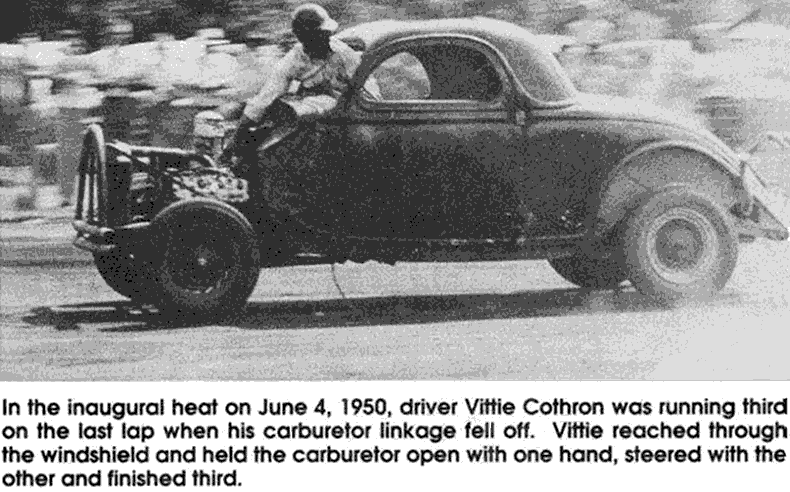
Vittie was racing a modified 1936 Ford three-window coupe. (posted 5/28/19, permalink)
Ahead Of Its Time: Constructed just after World War II, the 1946 Beechcraft Plainsman was a gas-electric hybrid four-door fastback sedan, with seating for six, all-wheel drive, individual one-per-wheel electric motors, air suspension, monocoque construction, motor-assist braking, advanced cruise control and advanced traction control.
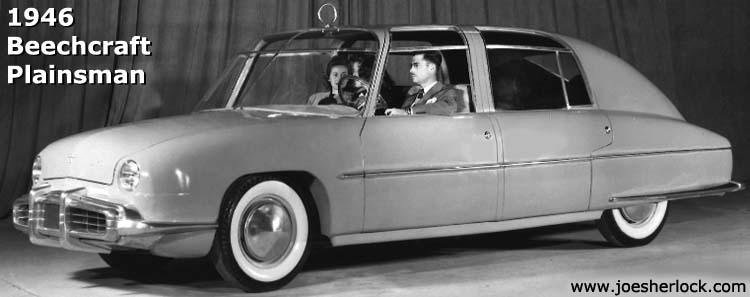
The prototype was constructed with an aluminum body by Beach Aircraft Co. of Wichita, Kansas It had a wraparound windshield, large wrap over windows and generally futuristic styling, with a front end somewhat reminiscent of a 1949 Lincoln.
After the war ended, many firms had excess production capacity and were searching for ways to keep business from contracting. Some efforts succeeded; some didn't. This is an idea that never came to fruition, likely because the cost of this advanced automobile made it uncompetitive. (posted 4/26/19, permalink)
Rohm and Haas Explorer Concept Cars: In the 1960s, Rohm and Haas Co., a Philadelphia-based chemical and plastics firm - best known for its acrylic thermoplastic, Plexiglas, developed a series of five 'Explorer' concept cars to showcase the use of Plexiglas as well as other Rohm and Haas products in automobiles.
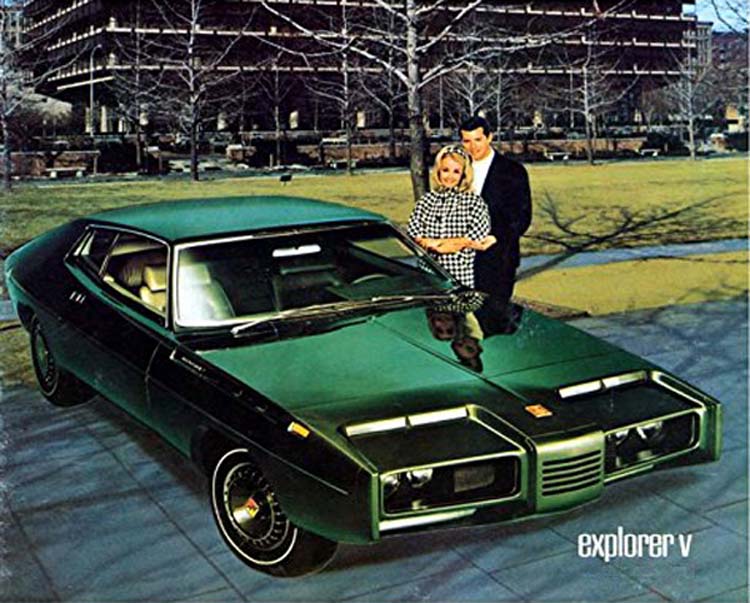
Most Explorer cars had four things in common … (more >>>)
Giant Car Lighter: Once upon a time, when most people smoked, Zippo was a popular and durable cigarette lighter. Since its introduction in 1933, Zippos have been sold around the world and have been described "a legendary and distinct symbol of Americana."
In 1947, Zippo lighter founder George G. Blaisdell commissioned a Zippomobile, a conversion of a 1947 Chrysler Saratoga to a product-mobile, with larger-than-life twin Zippo lighters forming the passenger compartment, neon flames stretching above the roofline. The Chrysler had a public address system, radio, and tape recorder, to play music over the p.a. Gardner Display of Pittsburgh to design the vehicle.
Through the late ‘40s and early ‘50s, the Zippo Car traveled to all 48 contiguous states, participating in special events, trade expos, fairs and leading parades. The original vehicle was lost but a replica was created in 1998 and can be seen from time to time at various events. (posted 4/4/19, permalink)
 2019 Consumer Reports Annual Auto Issue: Consumers Union began as a socialist organization in the 1930s and was once declared a subversive organization by the House Un-American Activities Committee. They still come off as a bunch of anti-capitalist lefties sometimes but Consumer Reports magazine remains the most comprehensive and believable of vehicle reliability surveys. This year's issue seemed to offer fewer data and more opinion than in prior years. 2019 Consumer Reports Annual Auto Issue: Consumers Union began as a socialist organization in the 1930s and was once declared a subversive organization by the House Un-American Activities Committee. They still come off as a bunch of anti-capitalist lefties sometimes but Consumer Reports magazine remains the most comprehensive and believable of vehicle reliability surveys. This year's issue seemed to offer fewer data and more opinion than in prior years.
CR's database comes from vehicles owned by subscribers who fill out Consumer Reports' annual survey. Cars which are awarded the coveted Top Picks or Buy Recommendation now only need to score 'average' in reliability.
Here are some interesting tidbits from the magazine:
• I am astounded by the range of vehicles to choose from these days. I once fancied myself as a car guru who knew exactly what a vehicle was when someone mentioned it. Now I don't even recognize some of the model designations.
• Despite the variety of models, most vehicles - especially SUVs - look the same to me. Whatever happened to style?
• There are some vehicles which are best referred to as cult cars - they have dismal reliability but owner satisfaction is quite high. There are some obvious ones, such as the Chevy Corvette and Camaro, Alfa Romeo Giulia, Jaguar F-Type, and Maserati, Tesla and Jeep Wrangler. But some unexpected cars, with poor reliability but high owner-love include the Buick Enclave, Cadillac CTS, Honda Clarity, Chevy Traverse SUV, Chrysler Pacifica minivan, Kia Cadenza sedan, Jaguar I-Pace (electrified crossover), and Ram 1500 pickup.
• On the other hand, there are vehicles which CR doesn't rate too badly but owners hate them. They include the Civic-based Acura ILX, the now-discontinued Chevy Cruze, Chevy Sonic subcompact and the Infiniti QX30 small crossover.
• Genesis vehicles sell poorly, despite good marks from CR's testers and owners who are very satisfied with their purchases.
• Some vehicles are just awful - poorly-rated by CR and having very unsatisfied owners. The list includes Fiat 500L and 500X, Dodge Journey, Ford Fiesta, Land Rover Discovery and Discovery Sport and the diesel version of the Nissan Titan.
• The magazine lists how vehicle brands stack up overall, based on performance, reliability and owner satisfaction. The top five spots are held by Subaru, Genesis, Porsche, Audi and Lexus. The bottom spots were awarded to Fiat, Jaguar, Land Rover, Mitsubishi and Jeep. Cadillac has nothing to brag about ranking 8th from the bottom. Lincoln is the exact opposite - eight from the top.
• CR has listed the ten least reliable vehicles for 2019: Jaguar F-Pace, Buick Enclave, Tesla Model X, Chevrolet Silverado 2500HD, Cadillac CT6, Cadillac Escalade, Kia Cadenza, Alfa Romeo Giulia, Cadillac CTS and Volkswagen Atlas. Notice that half the vehicles are GM products. Sad.
I still put much stock in Consumer Reports' comprehensive vehicle survey data analysis. I recommend that you pick up a copy of the April issue for reference while it's still available. (posted 3/27/19, permalink)
Cute Rarity: The Nissan S-Cargo was a subcompact delivery vehicle, based on the very small Nissan Micra. First offered in 1989, the S-Cargo's peculiar shape was an homage to the Citroën 2CV and the overall side profile was somewhat snail like. Hence the pronunciation: escargot.
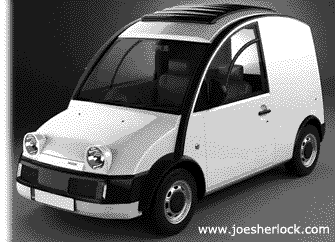
These RHD mini-trucks were not imported to the U.S. although several found their way to the UK. I remember seeing a bright green one parked on the street in London during a 1991 visit. We saw another one - done up as a flower delivery van - during our trip to Vancouver, BC in 2012.
They looked cuter and odder in person. (posted 3/25/19, permalink)
George Barris Is Dead … but his Golden Sahara has been resurrected.
The Golden Sahara is remembered as one of the most outlandish custom cars of the 1950s – and "it only came to be because George Barris and a friend accidentally drove a brand new 1953 Lincoln Capri Hardtop under the back of a hay truck – guillotining the roof off. Fortunately the two men ducked and kept their heads, but the Lincoln was beyond repair." Thus began the story of the Golden Sahara custom car.

When the custom car "made its debut in 1954 at the Petersen Motorama held at the Pan Pacific Auditorium in Los Angeles, it was displayed on a turntable so attendees would get a full 360º view of the car no matter where they were standing. After this, the car would tour the USA being displayed at various shows and dealerships – the latter would pay handsomely to have the car on show as it would attract large crowds – some of whom bought cars while they were there."
The car was updated to include quad tailfins and other features in 1956 or '57 and was renamed the Golden Sahara II.
The car has been restored and, inexplicably, was on display at the 2019 Geneva Auto Show in Goodyear's booth. The car was equipped with vintage reproductions of experimental Goodyear translucent illuminated tires. (posted 3/21/19, permalink)
Child Safety In The Good Old Days: What was automotive child safety like in the 1940s and '50s? Pretty much nonexistent.
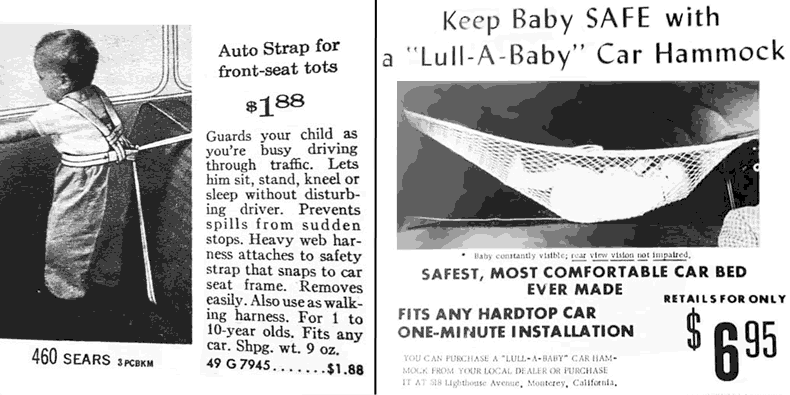
Back in 1954, Howard Gandelot, aVehicle Safety Engineer at General Motors Corporation, wrote ... (more >>>)
Book Review: 'Railroading & The Automobile Industry' by Jeff Wilson
PLS, shorthand for Pack, Load and Ship, is a line-item on the financial statements of almost all manufacturers and many distributors. It refers to the actual expense of packaging products, loading them onto a delivery conveyance and the cost of shipping or delivering them. PLS adds nothing of value to the product or consumer's conception of the product and reduction of PLS expense is an ongoing quest for smart manufacturers. Doing so will either add to their profit or allow them to improve the actual product in some way to make it better or more competitive.
PLS varies greatly, depending on what business you're in. At Rohm and Haas Co. in the 1970s, injection-molding grade, bulk pelted Plexiglas - mostly sold in 300-pound fiberboard drums or 1200-pound cardboard totes mounted on wood pallets - averaged 3%. At my plastics display company - where customer orders were smaller and always varied: "Gimme three dozen of this and six of that and sixteen of the other thing." - our PLS averaged around 10% for products shipped in cardboard cartons partially-filled with protective foam peanuts.
This book is all about PLS as it relates to inbound auto components or outbound finished vehicles at automobile assembly plants. This 96-page, large format (8.2" x 10.8") paperback book contains about 200 photographs (a mix of b&w and color) and tells the history of rail shipping automobiles and component parts.
In the early days of the automobile ... (more >>>)
Suddenly, It's 1936: The Glacier National Park Red Bus Fleet (White Motor Company Model 706 red passenger buses), on duty at the popular Montana tourist attraction since 1936, will be converted to a more environmentally friendly hybrid as part of a total overhaul. Ford Motor company rebuilt them 20 years ago, adapting the bus bodies to E-series Van chassis and propane systems. Since then, each bus has logged between 130,000 and 150,000 miles, averaging 10,000 each year.
Now the iconic buses are scheduled for a second rebuild. Every bus will get a new Ford chassis and Ford 6.2L V-8 engine. The powertrain will be bolstered by a pass-through hybrid electrical system that will increase fuel economy and lower emissions by up to 25%, the wheels will be upgraded to 19.5-inch-tall wheels to replicate the original 1930s’ units, and retro-looking gauges will be added to give the buses a period-correct appearance. Bus bodies will undergo rust-repair and be re-painted on an as-needed basis.
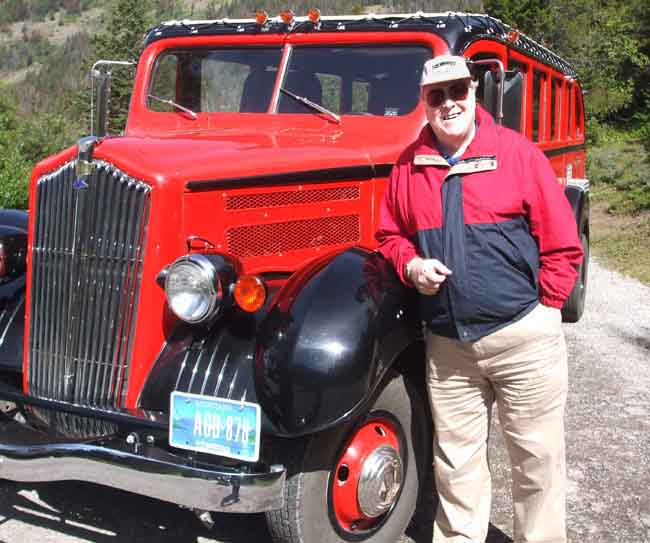
In August 2009, we took the Going-to-the-Sun Road tour in Glacier National Park in northwestern Montana. Appropriately, we toured the park in a 1937 White Motor Coach. The bus held 17 people (four rows of four across plus one next to the driver) and has a rollback canvas roof which provides spectacular views. The White Motor Company built these 25-foot-long vehicles from 1936 to 1939; the Glacier Park ones are painted "ripe mountain ash berry red." Originally powered by a straight-six truck motor with a four-speed manual transmission, the buses were once driven by 'Jammers', college students who would jam the non-synchro tranny into lower gears during steep climbs. Our driver, Bill - a fine tour guide, was a Jammer as a student back in '61.
The seats and dimensions are mostly original and after eight-plus hours of touring, you're ready for a couple of Aleves and a cocktail or two. There's not much legroom and the four across seats were designed for half-starved Depression-era Joads. Not Supersized Boomers. Thank goodness none of our seatmates were wearing jodhpurs. (posted 2/15/19, permalink)
It's A Shame About Ford: I won't belabor Ford's long and proud history - we all know how the Model T changed the world, etc.

I will mention its notable accomplishments over the past three decades. First, Ford Motor Company is the only one of the Detroit Three that didn't need a government bailout during the 2008-09 financial crisis - a big deal. Secondly, Ford has had notable product successes. The 1992 Ford Explorer brought the family SUV into the mainstream. The 1998 Lincoln Navigator was the first American luxury SUV. The 2001 Ford Escape was one of the first crossover utility vehicles and remains one of Ford's best-selling vehicles in the U.S. The retro-styled 2005 Mustang revived the ailing brand and gave Ford's ponycar new life. In 2018, the Mustang handily outsold the Dodge Challenger and Chevrolet Camaro. The F-Series pickups, which have been the best-selling vehicle in the United States for 42 years, retained its top spot for 2018.
 In 2018, Ford Motor Company's sales dropped 4% to 2.5 million units, placing it third behind General Motors and Toyota. General Motors' sales were down 2% to 2.95 million light vehicles. Fourth-ranked Fiat Chrysler Automobiles' annual U.S. sales rose 9% in 2018 to 2.24 million units. FCA has hit the magic sweet spot - the strong and iconic Jeep brand and the popular Ram truck line - which account for more than 70% of the company's sales. In 2018, Ford Motor Company's sales dropped 4% to 2.5 million units, placing it third behind General Motors and Toyota. General Motors' sales were down 2% to 2.95 million light vehicles. Fourth-ranked Fiat Chrysler Automobiles' annual U.S. sales rose 9% in 2018 to 2.24 million units. FCA has hit the magic sweet spot - the strong and iconic Jeep brand and the popular Ram truck line - which account for more than 70% of the company's sales.
Ford's net income fell by more than half in 2018. Here's why:
• $1.8 billion in higher commodity costs, mostly caused by tariffs on imported materials.
• Lower sales in China - a $1.7 billion impact. Ford's equity income from its joint ventures with Chinese automakers swung from a $916 million profit in 2017 to a $110 million loss in 2018, a decline of just over $1 billion. Ford's royalty payments from those joint-venture partners fell by an additional $266 million.
• $775 million expenses due to recalls, mostly due to defective airbag inflators made by now-defunct Japanese supplier Takata.
• $750 million due to unfavorable exchange rates, mostly South America and Brexit-related.
• Ford's EBIT (Earnings Before Interest & Taxes) in Europe fell from a $367 million profit in 2017 to a $398 million loss in 2018, a decline of $765 million.
Meanwhile, General Motors 2018 earnings topped expectations and the carmaker foresees strong earnings in 2019 as well, affirming strength in its largest markets.
Ford continues to struggle with a turnaround that has extended almost two years. Sales of its top 10 vehicles in the United States are essential to its financial future but those sales are mixed. The F-Series makes up 36% of Ford's sales in the United States. Ford's next best-selling vehicle in the United States is its small Escape crossover, which competes in one of the most crowded car segments in America. The Escape had a tough year in 2018; sales dropped 12% to 272,228, behind class competitors Toyota RAV4, Nissan Rogue, Honda CR-V and Chevrolet Equinox. Sales of the third best-selling car, the Explorer sport utility vehicle, also fell, down 4% to 227,732. It is still the best-selling vehicle in its class, just ahead of the Toyota Highlander and Jeep Grand Cherokee. In road tests and consumer clinics, neither the Escape nor Explorer are class-leading vehicles; they typically receive mediocre scores.
Ford's fourth-quarter revenue rose only 1% to $41.8 billion and it lost $0.1 billion. Sales in Europe and China were troubled - sales in Europe fell 3%. In China, Ford's 2018 sales totaled 752,243 units - a drop of 37%. The big drop was attributed to lagging sales at the company's Changan Ford Automobile joint venture, where sales fell by almost half.
Early this year, Ford announced a loose joint venture with Volkswagen to examine where cars will be built in the future for the European, U.S. and Chinese markets and to work together to fend off potential competitors in the self-driving car market.
In 2015, the company spent about 35% of its investment dollars on SUVs and crossovers. The new plan increases the investment to 52%. Trucks had been targeted for 32% of investment in 2015, and that has risen to 42% under the new plan. Passenger cars have dropped from 33% of planned spending in 2015 to just 6% under the new plan. This seems reasonable. Whether Ford can inject some excellence and consumer excitement into its future offerings is yet to be seen.
Recent changes to the vehicle market pose problems for all manufacturers, although Ford Motor Company seems to be hardest hit:
• There is a vast array of models available in the marketplace. Thirty years ago, there were far fewer models and configurations available. SUVs were few - now just about every manufacturer offers several. Lexus, Infiniti and Tesla did not exist as luxury marques. Pickup trucks were primarily work trucks. In 1989, the top-selling luxury brands in the U.S. were Cadillac (276.330 units sold) and Lincoln (215,966). In 2018, the top luxury brands were Mercedes-Benz, BMW, Lexus, Audi and Tesla. How times have changed!
• More and more vehicles are leased and the 'deal' becomes more important than the vehicle brand or features. Buyer loyalty has been declining for years; leasing has increased the rate of decline. No one is a Ford Man anymore. Auto purchases made by my children and their spouses over the past 20-plus years typify the new world of no-brand-loyalty:
Geo>Hyundai>Honda
Volkswagen>Ford>Toyota
Oldsmobile>Saturn>Honda>Subaru
Chevrolet>Toyota
• SUVs and crossovers are replacing sedans, coupes and vans as the family vehicle. Manufacturers are struggling to adjust production and future product planning to accommodate the market shift.
• Everybody is talking about electric vehicles but no one knows if the market is real or phantom. Charging is still much slower than gasoline fill-ups, cold weather can drop a battery's output by 40% and charging infrastructure remains spotty. Tesla seems to have too much Model 3 inventory due to lessened demand and is forecasting a loss in the first quarter. Interestingly, Toyota has no plans to build an electric cars, sticking with hybrids instead.
• Everybody is talking about autonomous vehicles but no one knows how or when the technology will be implemented. Basic questions remain unanswered - such as how sensors can tell where the road is when the lane markers are covered with snow and how to determine fault after an accident. Will victims sue the driver? The manufacturer? The component supplier? The software provider?
• All SUVs look the same, except for some brands which have distinctive, iconic front ends (Jeep, Mercedes-Benz, Porsche, BMW, Cadillac, Volkswagen and Buick for example). Viewed from the side, SUVs are two-box, mostly-unimaginative designs. Even the wheels aren't particularly distinctive. (I wrote about the sameness of wheels in 2003 and included some photo comparisons.)
Mustangs look like Mustangs, Jeeps look like Jeeps but Ford doesn't seem to know what an Escape or Explorer should look like. There's no design continuity. I wish Ford the best of luck but they better up their game … soon. (posted 2/11/19, permalink)
Back Where It Came From: This 1963 automotive tip may be horrifying to today's ecology-minded youngsters but, 50 years ago, the prevailing wisdom was that oil came out of the ground so why not return it to the ground.
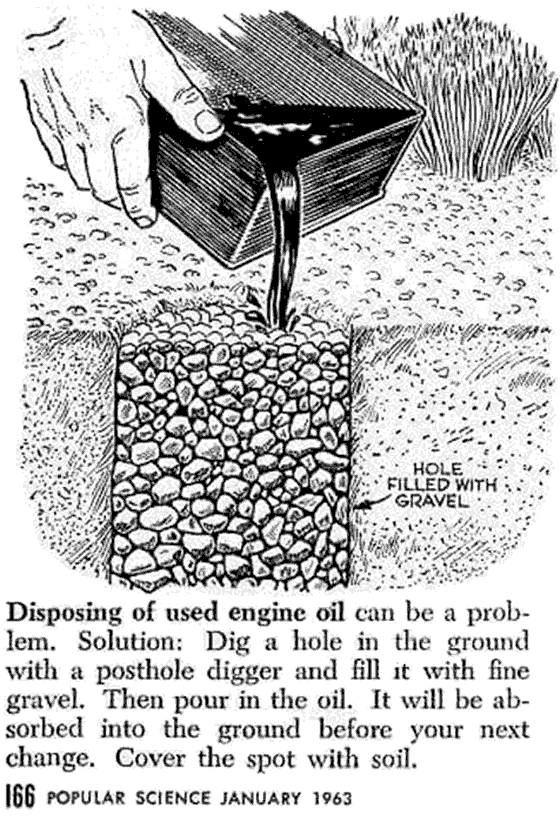
Most dirt is a great filter, especially diatomaceous earth. (posted 2/7/19, permalink)
Diamond-Patterned Oddball: Mac's Motor City Garage has posted an article on the 1960 Pininfarina X - a distinctive but odd-looking concept car which looked like a three-wheeled sedan but with its four wheels arranged in a diamond pattern (one in front, two in the middle and one in the back) in a quest for aerodynamics.
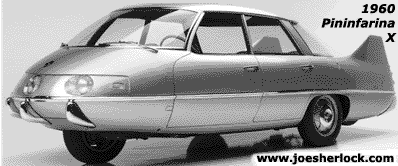 "Batista 'Pinin' Farina, who legally changed his last name to Pininfarina in 1961, was among the most popular and productive Italian coachbuilders of the classic postwar era, with clients ranging from Fiat to Ferrari to Cadillac. Streamlining was a frequent area of design exploration at the time, naturally, and in 1958, his company partnered with Professore Alberto Morelli of the Politecnico di Torino to identify the ideal aerodynamic design. The result was the 1960 Pininfarina X, also known as the PFX." "Batista 'Pinin' Farina, who legally changed his last name to Pininfarina in 1961, was among the most popular and productive Italian coachbuilders of the classic postwar era, with clients ranging from Fiat to Ferrari to Cadillac. Streamlining was a frequent area of design exploration at the time, naturally, and in 1958, his company partnered with Professore Alberto Morelli of the Politecnico di Torino to identify the ideal aerodynamic design. The result was the 1960 Pininfarina X, also known as the PFX."
"Since a teardrop is said to be the optimum aerodynamic shape, Morelli casually tossed away the conventional automotive chassis layout with a wheel at each corner and adopted a rhomboid or X-chassis configuration, above. (Hence the name Pininfarina X.) There was one steering wheel at the front and a single drive wheel at the rear, with two more wheels toward the center to complete the diamond form and steady the platform. The single prototype was powered by a 1089cc Fiat inline four with 43 hp and a four-speed manual gearbox, installed diagonally in the chassis to maximize cabin and cargo volume. Overall length was not quite 170 inches with ample room for four adults.
The large tail fins at the rear were no styling flourish, Pininfarina reported, but were required for stability, in part due to the extremely slippery shape. The claimed drag coefficient was an impressive .23 (.219 according to one interview with Morelli) but the car’s highway behavior is essentially a question mark.
It's said that Batista Pininfarina frequently drove the PFX on the road while shopping it around to various carmakers, but there were no hand-raisers for the 1-2-1 rhomboid design."
The Pininfarina X was auctioned off at the 2015 Barrett-Jackson Scottsdale auction with a winning bid of $300,000. That's quite a comedown from the original $3 million asking price. I saw the Pininfarina X in person at the New York Auto Show in the 1960s. The little four-door sedan looked even stranger in person than in photographs. (posted 2/1/19, permalink)
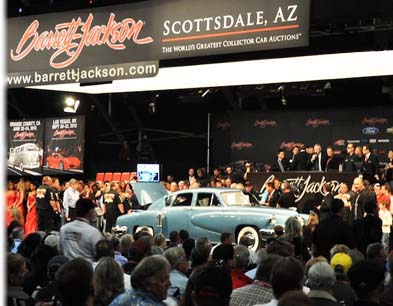 2019 Scottsdale Collector Auto Auctions: F. Scott Fitzgerald once wrote, "Let me tell you about the very rich. They are different from you and me. They possess and enjoy early, and it does something to them, makes them soft, where we are hard, cynical where we are trustful, in a way that, unless you were born rich, it is very difficult to understand." 2019 Scottsdale Collector Auto Auctions: F. Scott Fitzgerald once wrote, "Let me tell you about the very rich. They are different from you and me. They possess and enjoy early, and it does something to them, makes them soft, where we are hard, cynical where we are trustful, in a way that, unless you were born rich, it is very difficult to understand."
Yes, the rich are indeed different. Someone who pays millions for a single Ferrari does not just have one collector car. Or one Ferrari. Typically, he has a collection - 20 to 50 cars. He employs several mechanics just to care for them. Often, such folk own a tricked-out enclosed car carrier to transport their prized vehicles to shows. It's fair to assume that this person's collection is worth north of $30 million. The kind of person who has such a collection is quite rich, probably worth a half-billion or more.
This man is likely a first or second generation business owner, with a firm large enough to allow his sheet metal indulgences, including the time off to travel to auctions and hobnob with other, like-minded collectors.
This year's various Arizona vehicle auctions were full of middle-aged (and older) white dudes with buckets of cash bidding against each other, as they sought their automotive nirvana du jour. Or the nostalgia of their youth.
How old are these guys? Looking at the televised Barrett-Jackson events, I'd guess that the age of the average seat holder was 50-65. Hemmings Motor News used to claim that its average subscriber was 52 years-old. And that number didn't change much from decade to decade. It makes sense: By one's early 50s, the kids are out of college and out of the house, the mortgage is shrinking (or paid off) and it's usually peak income time at work. This adds up to Disposable Income to spend on various toys.
Analysts from Hagerty, who followed the Arizona auction action, reported that sales have improved by 11% in the numbers of vehicles sold and by 17% in the prices paid, compared with the same events a year ago. But there's a caveat: Dave Kinney, publisher of the Hagerty Price Guide, said, "Cars below $250,000 are accelerating but offerings above that need a jump-start. Distilled down, big-dollar players are sitting on their hands while the most accessible vehicles are attracting all the bidding."
One measure of the polarization is sell-through rate, how many vehicles in a price range actually are being sold. Hagerty reports that the sell-through rate for vehicles valued at more than $500,000 has been 54% at the various auctions. Those worth $1 million or more have sold at only a 36% rate. The overall sell-through for all vehicles offered up for bidding so far has been 80%. Based on what I saw on television, the sell-through rate seemed extraordinarily high this year. Final numbers indicated an 80% sell-through rate overall.
Total sales this year have been within 1% of 2018 figures.
Ferraris always bring big bucks. Gooding & Co. sold a Rosso Corsa (red) 1963 Ferrari 250 GT SWB Coupe for $7,595,000, a 1958 Ferrari 250 GT TdF Coupe for $5,890,000 and a 1953 Ferrari 250 MM Spider for $5,395,000. RM Sotheby's gaveled a 1985 Ferrari 288 GTO Coupe for $3,360,000. But ... RM estimated that a dark metallic silver (color listed as "Grigio Fumo Max Meyer" in the catalog) 1957 Ferrari 250 GT Coupe Speciale with an attractive one-off Pininfarina coachwork, built exclusively for Lilian, Princess of Réthy, the royal lady of Belgium, would sell for $11-13 million, but it was a no-sale when the bidding called at $7.5 million.
RM Sotheby's successfully auctioned a Waltz Blue 1948 Tucker fee-inclusive $1.6 million and a 1958 BMW 507 Series II roadster for $2,175 million. It should be noted that Elvis Presley once owned a white 1957 BMW 507 roadster. He bought the car while in the U.S. Army and stationed in Germany and used the BMW to drive between his home in Bad Nauheim and the US Army Base in Friedberg. Elvis' 507 was restored and subsequently displayed at Pebble Beach in 2016.
There were many hours of the Barrett-Jackson auction carried on Motor Trend TV and I watched all of it, mostly on fast-forward. The auction was full of 1960s and ’70s muscle cars, including a large contingent of Camaros, Mustangs and Corvettes. There were dozens of air-cooled Porsches of all years and combinations. Iowahawk Dave Burge, who also binge-watched Barrett-Jackson, tweeted, "It's weird to watch three liquored-up lummoxes bid a Sizzle Green 1968 Bulgemobile Maniac X99 P-Code up to $175k where there are two dozen Sizzle Green 1968 Bulgemobile Maniac X99 P-Codes on Hemmings for sale at $60k." He's probably referring to some of the overpriced, over-restored muscle cars fitted with giant, hideous, incorrect wheels. At Barrett-Jackson in particular, the average sale price of resto-mods and custom vehicles jumped 22% year-over-year to $73,150. Dave added, "Don't know what bugs me more, people crazily overpaying for cars or people crazily underpaying for cars."
The high-dollar auction sales always make the news but I find the low-to-medium priced vehicles far more interesting. I slowed down the DVR whenever I saw cars that caught my eye:
• A handsome, Gordon M. Buehrig-designed burgundy 1937 Cord 812 supercharged convertible found a buyer at $210,000. The first American front-wheel drive car with independent front suspension caused a sensation at the New York Auto Show in November 1935. The crowds around the new Cord were so dense that attendees stood on the bumpers of nearby cars just to get a look. Many orders were taken at the show but no production vehicles were available until February 1936. Five years ago, a similar 812 fetched only $150,000.
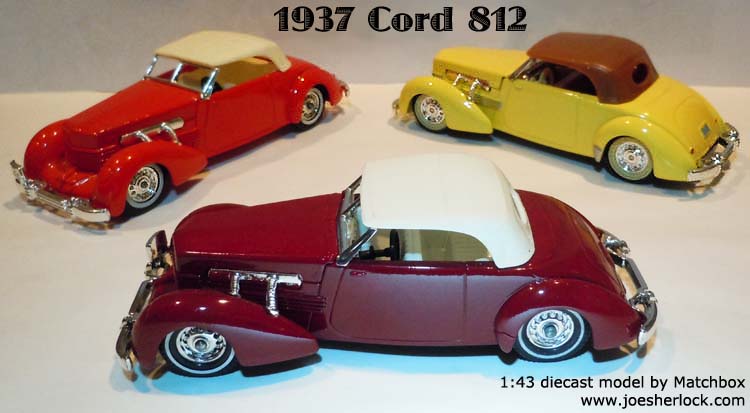
I've designated the 1936-37 Cord 810/812 as one of the Ten Best-Looking American Production Cars.
• A maroon 1938 Ford Deluxe four-door phaeton with a stock-looking body, custom white leather upholstery and powered by a flathead V8 engine with two period-correct Stromberg carburetors and a 3-speed manual transmission, equipped with hydraulic brakes, dropped front axle, fender skirts, wide whitewall tires was sold for at a seeming bargain price of $23,000. Dave Burge tweeted, "I'm kicking my own ass through the tears for not jumping on that." Me too.
By contrast, a teal 1939 Ford rumble seat convertible coupe went under the gavel for $58,000.
• A maroon 1940 Lincoln Zephyr three-window coupe - a claimed $100,000 restoration with a slightly hopped-up flathead V12 engine (using vintage Edmunds speed equipment) - fetched $53,000, a beauty at an almost-bargain price. Only 1,256 three-window Zephyr coupes were made in 1940.
• A bright-blue restored 1940 Plymouth DeLuxe four-door sedan, restored to stock condition, sold for $24,000, far lest than the restoration cost. It was powered by the same flathead six-cylinder engine used by Plymouth from 1935 trough '59, although they did offer optional ohv V8s from 1955 on.
• A dark green, restored 1950 Dodge Power Wagon genuine woody wagon - I had never seen one before - went under the gavel for $100,000.
• A dark blue 1951 Ford Country Squire woody wagon - the last year of the real wood Ford woodies - fetched $72,000. Seemed like a fair price to me.
• A nicely-restored 1951 Frazer Manhattan four-door convertible finished in black with a red canvas roof was one of only 130 made that year and sold for only $29,000 - a steal at that price.
• A restored black 1953 Buick Super Estate woody wagon with red leather interior, powered by at the stock 170-horsepower nailhead V8 and Dynaflow transmission fetched $100,000. Only 1,830 examples were made in '53.
• A fire-engine red 1953 Buick Skylark convertible with white leather interior went under the gavel at $115,000. This restored auto had the original Fireball V8 engine which produced 188 horsepower. Only 1,690 examples were produced and were originally priced at $5,000 - a lot of dough in '53.
• A Polo White 1953 Chevrolet Corvette roadster, #290 of 300 produced at the Flint, Michigan makeshift assembly line, was sold for $190,000.
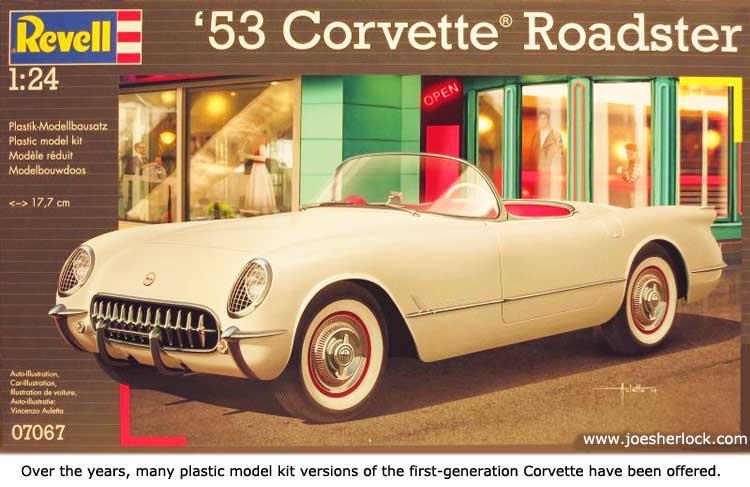
• A red 1954 Kaiser-Darrin with the stock 161 cubic-inch six-cylinder engine and three-speed manual transmission sold for a relatively low $82,000. In 2015, a pale yellow example fetched $176,000. In 2013, a pale green one sold at B-J Scottsdale for $180,000. Only 435 Kaiser Darrins were made.
• A restored 1955 Chevrolet Nomad wagon, finished in Shadow Gray over Coral and powered by a 265 cu. in. V8 with Powerpack coupled to a two-speed Powerglide automatic transmission fetched $70,000. 8,386 Nomads were produced in 1955.
• An original 1957 Buick Roadmaster two-door hardtop coupe, with less than 20,000 original miles on the odometer and finished in its original color scheme of Shell Beige over Seminole Red, sold for $70,000.
• A blue 1957 Oldsmobile 98 Starfire convertible with the J-2 tri-carb engine package sold for $100,000.
• A black 1957 Studebaker Golden Hawk with a polished aluminum fin insert fetched only $25,000. Golden Hawks usually command twice that price.
• A metallic silver-blue 1958 Buick Century convertible with 31,000 original miles sold for $90,000.
• A white 1958 Continental Mark III convertible with a white, black and red interior gaveled down at $58,000. Once derided by collectors, the 1958-60 Forgotten Marks have now become popular, with prices rivaling those of the more popular and more plentiful 1961-67 slabside Lincoln convertibles four years ago.
• A black 1958 Oldsmobile Dymamic 88 convertible with the J-2 tri-carb engine package sold for $92,000.
• A red 1959 Mercury Monterey convertible crossed the auction block at $40,000. '59 Mercs are a rarity and the price seemed like a bargain for this uniquely-styled fifties convertible. In 1959, 4,426 Monterey convertibles were produced.
• A white Cadillac Series 62 convertible with red leather interior fetched $85,000.
• A red 1960 Cadillac Eldorado Biarritz convertible with a white leather interior sold for $75,000.
• A candy-apple-red, mildly-customized 1961 Oldsmobile Starfire, with white leather interior and powered by a 394 cubic-inch Rocket 88 V8 coupled to a four-speed Hydramatic transmission, sold for $70,000.
• A silver-blue 1962 Mercedes-Benz 190 SL with a black convertible top sold for $120,000. A 1961 black one fetched $125,000, while a '57 black example found a buyer at $85,000.
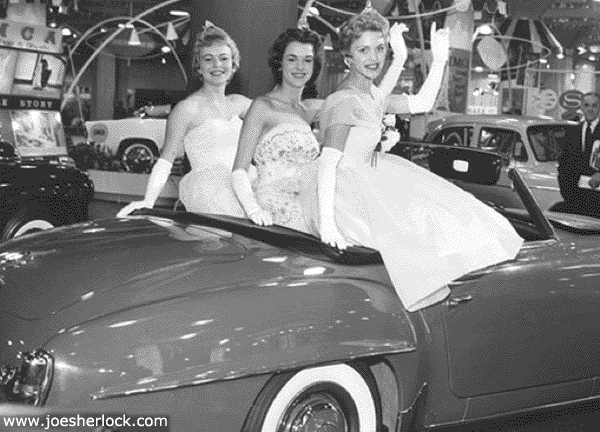
These cars were underpowered and therefore fairly slow and not very sporty. In the U.S., they were popular with wealthy women and debutantes. I think 190s have become popular because they somewhat resemble their far more expensive and powerful brethren, the Germanically handsome and awesome 300 SL.
• A black 1963 Lincoln Continental four-door convertible fetched a cool $100,000. That seemed like a lot of money to me. In 2015 a triple-black example sold at Scottsdale for $55,000. In '63, Lincoln produced 3,138 convertibles. Later, a triple-black 1964 Lincoln Continental convertible crossed the block at $112,000.
• A very nice, pale-yellow 1964 Chevrolet Corvair Monza Spyder convertible with the turbocharged 150 horsepower flat-six air-cooled engine sold for a bargain-basement $16,500. Fifty-five later, GM’s answer to Volkswagen is still unloved.
• A white 1965 Buick Rivera GS, which had a more powerful engine than the standard Riviera, went under the gavel for $50,000. A maroon GS fetched $60,000.

My good friend Marty Hayes was the best man at my wedding and transported my new bride and me in his dad's dark green 1965 Riviera. So I have a soft spot for '65 Rivs.
• A silver 1967 modified Mustang fastback - one of two running Eleanors used in the movie 'Gone in 60 Seconds' - sold for $350,000.
• A red 1971 De Tomato Pantera sold for $97,000. A yellow '73 model sold for $56,000, while a red ’73 Pantera sold for $95,000.
• A gold 1978 Pontiac Firebird coupe, driven by James Garner in 'The Rockford Files' television series', fetched $103,000.
Money-wise, the 2019 Scottsdale Auctions demonstrated that there are plenty of dollars around and the collector car market is doing OK. People are feeling optimistic about the future and the very wealthy don't seem to have a care in the world. You see, they're different from you and me. (posted 1/24/19, permalink)
British Invasion: The Simeone Foundation Automotive Museum in Philadelphia will feature the storied Bentley marque in its annual Best of Britain exhibit opening in ... (more >>>)
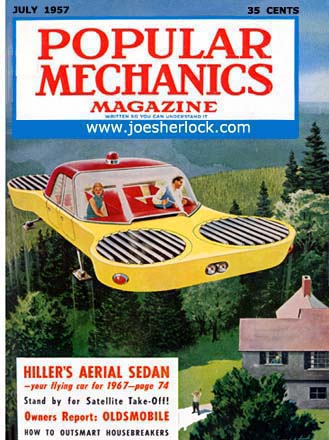 2019 Detroit Auto Show: As regular readers know, the first auto show I ever attended was the 1960 Philadelphia Auto Show in November 1959. Ever since then, I have faithfully followed auto show coverage because I wanted to see what the future held by looking at all the wild concept cars on display. In those days, everyone said the future would involve gas turbine engines, Plexiglas bubble roofs and flying cars. Never happened. 2019 Detroit Auto Show: As regular readers know, the first auto show I ever attended was the 1960 Philadelphia Auto Show in November 1959. Ever since then, I have faithfully followed auto show coverage because I wanted to see what the future held by looking at all the wild concept cars on display. In those days, everyone said the future would involve gas turbine engines, Plexiglas bubble roofs and flying cars. Never happened.
Now auto experts claim that we will very soon be driving all-electric cars and/or riding in fully-autonomous vehicles. I've been burned so many times over my lifetime by pipe dreams that never happen, so I hope you'll understand if I'm skeptical about the predicted universality of electric vehicles and self-driving pods.
Jim Lentz, CEO of Toyota North America, is also skeptical of the proclaimed all-electric future. He pointed out "that only the Tesla Model 3, of all the electrified models now on the market currently is generating more than 10,000 sales per month. And of the 94 "electrified" vehicles on the market – including hybrids, plug-ins and pure battery-electric vehicles – only six top 2,000 a month." Lentz said, "It's going to be a battle," as manufacturers struggle to grab customers in a market where "there's not much growth."
Lentz tried to put the situation into perspective by pointing out that only the Tesla Model 3, of all the electrified models now on the market currently is generating more than 10,000 sales per month. And of the 94 "electrified" vehicles on the market – including hybrids, plug-ins and pure battery-electric vehicles – only six top 2,000 a month.
This year's Detroit Auto Show was light on debuts and lavish unveilings. Peter De Lorenzo, the AutoExtremist, described the show as "a snapshot of a fading industry wheezing through its last gasps of respectability." Ouch.
While Ford, General Motors and Toyota showed new vehicles, Audi, BMW, Mercedes, Porsche, and Jaguar Land Rover, along with such higher-end brands as Ferrari, McLaren, and Lamborghini, skipped it altogether.
The Toyota Supra had its official reveal; it's "a sports car with a capital S: a coupe with 50-50 weight distribution, a straight-six cylinder engine, an integrated spoiler, and 335 horsepower." Toyota hedged its exposure by splitting the development costs with BMW's upcoming Z4. The Supra will go on sale in the summer of 2020 at a BMW-like price of $50,000 or so. The Supra will be assembled in Austria by Magna Steyr, alongside its cousin, the BMW Z4.
Ford introduced the new Shelby GT 500, featuring a supercharged 700+ horsepower V8. The company says will make it the most powerful production car ever. Ford also showed the all-new 2020 Explorer SUV. The Kia Teluride made its debut; it's a large three-row SUV. Cadillac also showed a three-row luxury crossover, the XT6, designed to compete with the Lincoln Aviator and Audi Q7 and due in mid-2020. The in-between-size Caddy SUV shares its underpinnings with the Buick Enclave, Chevrolet Traverse and GMC Acadia.
The redesigned VW Passat sedan also made its formal debut. It looks like the old one to me. And its a stately sedan in an ugly SUV world.
The Lexus LC convertible concept is likely headed for production and it looks great except for that hideous gaping-maw grille, a Lexus family affliction not unlike a third-world country harelip. (posted 1/18/19, permalink)
Book Review: 'Ford Model T Coast to Coast: A Slow Drive Across A Fast Country' by Tom Cotter
Before the Model T came along, automobiles were mere playthings for the rich. Henry Ford's T didn't just put America on wheels, it put the world on wheels. The Model T was the first truly affordable car for the working man. Initially priced at $850 in 1908, the price dropped to $390 by 1914 due to production efficiencies. By 1927, a new Model T could be had for as little as $260. At its peak popularity, 1.25 million Model Ts were sold each year.
The Model T was effectively the first ... (more >>>)
 Book Review: 'Jaguar XK: A Celebration of Jaguar's 1950s Classic' by Nigel Thorley Book Review: 'Jaguar XK: A Celebration of Jaguar's 1950s Classic' by Nigel Thorley
Since its founding in the 1920s, Jaguar has always offered sporting cars. Yes, saloons were produced for gentlemen who required extra doors or wealthy, portly lads who couldn't fit in a sports car, but Jaguar's flagship was always a sports car.
When the Jaguar XK120 burst on the automotive scene at the 1948 London Motor Show, the British sports car stunned the public. Its swoopy lines were quite a contrast with other British two-seaters - as well as older Jags - and made all of them look stodgy and ancient by comparison. The XK 120 was wickedly fast for its time.
The original Jaguar XK was to be a four-cylinder car called the XK100. Thankfully, that idea was scrapped. The 1948 Jaguar XK120 was powered by a new overhead-cam six-cylinder engine used by Jaguar until 1992.
The XK120 became a big hit in the U.S., after the British government reduced ... (more >>>)
2018 Auto Sales: For calendar year 2018, new U.S. vehicle sales were 17.33 million cars and light trucks - making it the fourth-biggest year on record. Sales were up slightly from 17.2 million in 2017. Light trucks - pickups, SUVs and crossovers - accounted for a record 69% of the U.S. market.
 "New vehicle sales were surprisingly strong in 2018 despite late cycle headwinds from higher interest rates and more nearly-new competition in the used market," Cox Automotive Chief Economist Jonathan Smoke said. "The key positive factor was stimulated demand from tax reform, which strengthened retail demand as the year progressed and also enabled strong gains in fleet sales." "New vehicle sales were surprisingly strong in 2018 despite late cycle headwinds from higher interest rates and more nearly-new competition in the used market," Cox Automotive Chief Economist Jonathan Smoke said. "The key positive factor was stimulated demand from tax reform, which strengthened retail demand as the year progressed and also enabled strong gains in fleet sales."
Overall, U.S. light-truck sales (pickups, SUVs) rose 8% in 2018, while car deliveries slid 13% for the year, marking the fifth straight annual decline in car volume (sedans, coupes). Just over 20 models sold more than 200,000 units each last year, demonstrating how much the auto industry is concentrated on a few products. The five top sellers were Ford F-Series pickup truck, soon-to-be-discontinued Chevy Cruise sedan, Ram pickup, Toyota RAV4 crossover and Nissan Rogue crossover.
It was a very good year for pickup trucks: 909,000 Ford F-Series, 585,000 Chevrolet Silverado and 536,000 Ram pickups were sold last year. Large pickups generate at least $17,000 a vehicle in pretax profit for GM and probably similar levels for Ford and FCA. By contrast, many Detroit Three sedans are so unprofitable, that their manufacturers have decided not to build them anymore. GM has said 27% of Chevrolet and GMC trucks - which can haul trailers by day and substitute for a luxury sedan by night - sell for more than $55,000.
For the full year, total Ford Motor Co. sales dropped by 4% to 2.5 million units, dragged down by an 18% slump in car sales. SUV sales rose fractionally and truck sales rose 1%. Full-year F-Series sales accounted for more than 36% of the company's total sales for the year. In an SUV-oriented market, Lincoln sales declined 7% to 103,587 vehicles. Sales of Ford and Lincoln cars sank 18% in 2018. Ford Mustang sales dropped 7% to 75,842 coupes. Sales of the Ford Focus were down 28%, while sales of the Lincoln Navigator increased 70% to 17,839 SUVs. The flagship Lincoln Continental experienced a sales decline of 37% to 8,758 sedans.
Fiat Chrysler Automobiles annual U.S. sales rose 9% in 2018 to 2.24 million units. Fleet sales were 21% of all sales. For the full year, Ram sales were up 7% compared to last year. For the full year, Chrysler sales are down 12% and Fiat sales plunged 41% to 15,521 vehicles. Alfa sales rose 98% for the full year to 23,820 units. The Stelvio SUV accounted for 12,043 sales in '18. For the full year, Dodge sales rose 3% to 459,324 units, with about a third accounted for by the new Caravan. 66,716 Dodge Challengers were sold, up 3% over last year. Jeep sales increased 17% to 973,227 vehicles; Jeep Cherokee sales increased 41%.
For the full year, General Motors sales were down 2% to 2.95 million light vehicles. The Chevy Silverado pickup and Equinox sport utility vehicle are the company's two best-selling vehicles, with full-year totals of 585,864 units and 290,458 units, respectively. GM light trucks and SUVs rose 2% for the year. But sales fell for the Chevrolet Suburban and the GMC Yukon, popular large SUVs that produce high margins. On the other hand, sales of the Cadillac Escalade jumped up 57% to 36,032 SUVs.
Sales were down 1% at Chevrolet to 2,036,023 units; sales of the Chevrolet Sonic fell 35% to 19,679 subcompact sedans. 47,203 Camaros found buyers in 2018, down 31% from 2017. Sales of the all-electric Chevy Bolt dropped 32% for the full year to 15,922 vehicles. Buick sales fell 6% to 207,223 units. Cadillac sales decreased 1% to 154,702 Caddies. Only 9,669 examples of the Cadillac CT6 found buyers, down 8% from 2017. GMC sales dropped 1% to 556,000 trucks and SUVs.
Toyota Motor Company's U.S. sales edged down fractionally, with car demand falling 12% and light-truck shipments up 8%. 2,128,367 Toyota-badged vehicles found buyers last year; sales were flat compared with 2017. Toyota sold 33,518 Avalon sedans in 2018, an increase of 3% over 2017. 427,170 RAV4 crossovers found buyers in 2018, up 5% from last year. Prius sales dropped 19% to 343,439 sedans.
The Honda brand was down 3%. Subaru had 2018 sales of 680,135, a gain of 5%. Honda's best-selling model was the CR-V; 379,013 found buyers in 2018, a fractional increase over last year. It was the tenth consecutive year of record U.S. sales for Subaru. Mazda reported a 4% increase in 2018 sales; more than half of those sold were CX-5 crossovers. Mitsubishi said its 2018 volume finished 14% higher at 118,074. 667,945 Hyundais found homes in 2018 - a fractional increase, while Kia sales were flat at 589,673 vehicles. Kia only sold 354 examples of its luxury K900 sedan in 2018.
Nissan sales dropped 6% in 2018. Nissan's Rogue was that company's top-selling model. Its 412,110 sales, an increase of 2%, was just passed by the Toyota RAV4. It was, however, the best calendar year for Rogue sales yet. Sales of the restyled, all-electric Leaf grew 31% over last year to 14,715 units. Volvo sold 92,263 vehicles in the U.S. last year - an increase of 21%. Mini sales fell 7% to 43,464 vehicles.
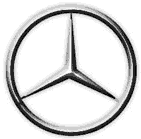 Mercedes-Benz sold 354,137 vehicles in 2018, a decline of 4%, but enough to make it the best-selling luxury marque in the U.S. 14,978 examples of the flagship Mercedes S-Class were sold, down 6% from last year. BMW sold 311,014 vehicles in 2018, an increase of 2% over last year. Only 6,120 examples of the all-electric BMW i3 were sold, a drop of 2%. Lexus sold 298,210 units in 2018 - a decline of 2%. 9,302 flagship Lexus LS sedans found buyers in 2018, up a whopping 127% from last year. The RX crossover is Lexus' most popular model; 111,641 were sold in 2018 an increase of 3% over last year. 223,323 Audis found homes last year, a decline of 1%. Mercedes-Benz sold 354,137 vehicles in 2018, a decline of 4%, but enough to make it the best-selling luxury marque in the U.S. 14,978 examples of the flagship Mercedes S-Class were sold, down 6% from last year. BMW sold 311,014 vehicles in 2018, an increase of 2% over last year. Only 6,120 examples of the all-electric BMW i3 were sold, a drop of 2%. Lexus sold 298,210 units in 2018 - a decline of 2%. 9,302 flagship Lexus LS sedans found buyers in 2018, up a whopping 127% from last year. The RX crossover is Lexus' most popular model; 111,641 were sold in 2018 an increase of 3% over last year. 223,323 Audis found homes last year, a decline of 1%.
Tesla reported sales of 184,200 electric vehicles in 2018; 140,317 were Model 3s. 158,934 Acuras found buyers last year, an increase of 3% over 2017. The RDX is Acura's best-selling model; 63,580 found buyers in 2018, an increase of 24% over last year. 149,280 Infiniti were sold last year, a drop of 3%. Land Rover sold 82,143 utility vehicles in 2018 - an increase of 23%. Porsche sold 57,202 units in America in 2018 - an increase of 3%. Jaguar sold 30,483 vehicles - a fall of 23% from last year. Maserati sold 11,263 vehicles in 2018, a drop of 18% from 2017. Genesis reported annual sales of 10,312 cars, falling 50% from 2017.
In the price-no-object segment of the market, Rolls-Royce sold 1,080 vehicles in the U.S. last year - an increase of 5%, while Bentley sold 1,972 vehicles, a decline of 18%. Lamborghini sold 1,128 vehicles, an increase of 3%. 1,569 McLarens found buyers last year - a jump of 41%. McLaren experienced its eighth consecutive year of increasing global sales since its formation in 2010. The company sold 4,806 new cars worldwide last year, representing a 44% jump last year. The U.S. is the company's largest single market with a third of McLaren's global sales. (posted 1/8/19, permalink)
Earlier Car Musings can be found here.
Other Pages Of Interest
| blog: 'The View Through The Windshield' |
| greatest hits: various essays & articles | blog archives | '39 Plymouth | model train layout |
| about me | about the blog | e-mail |
copyright 2019-21 - Joseph M. Sherlock - All applicable rights reserved
Disclaimer
The facts presented on this website are based on my best guesses and my substantially faulty geezer memory. The opinions expressed herein are strictly those of the author and are protected by the U.S. Constitution. Probably.
If I have slandered any brands of automobiles, either expressly or inadvertently, they're most likely crap cars and deserve it. Automobile manufacturers should be aware that they always have the option of trying to change my mind by providing me with vehicles to test drive. I'll dutifully report my road test impressions on this car blog.
If I have slandered any people or corporations, either expressly or inadvertently, they should buy me strong drinks (and an expensive meal) and try to prove to me that they're not the jerks I've portrayed them to be. If you're buying, I'm willing to listen.
| |